Paleoliquefaction Studies and the Evaluation of Seismic Hazard
Abstract
1. Introduction
2. Earthquake-Induced Liquefaction
2.1. Process of Liquefaction
2.2. Conditions That Influence the Formation of Liquefaction Features
2.3. Ground Motions That Cause Liquefaction
2.4. Earthquake-Induced Liquefaction Features
2.4.1. Blows, Dikes, Sills, and Diapirs
2.4.2. Soft-Sediment Deformation Structures within the Layer That Liquefied
2.4.3. Diagnostic Criteria for Earthquake-Induced Liquefaction Features
- (1)
- Sedimentary characteristics consistent with case histories of earthquake-induced liquefaction;
- (2)
- Sedimentary characteristics indicative of a sudden, strong, upwardly directed hydraulic force of short duration;
- (3)
- Occurrence of more than one type of liquefaction feature and of similar features at multiple nearby locations;
- (4)
- Occurrence in geomorphic settings where hydraulic conditions described in (2) would not develop under non-seismic conditions;
- (5)
- Age data to support both contemporaneous and episodic formation of features over a large area.
- (1)
- Liquefiable sediment is present or potentially present;
- (2)
- Deformational structures observed are similar to those formed experimentally or are shown to have formed during seismic events;
- (3)
- Structures are restricted to or originate from a single stratigraphic interval;
- (4)
- Zones of structures are correlated over large areas;
- (5)
- Absence of detectable influence by slopes, slope failures, or other sedimentological, biological, or deformational processes.
2.4.4. Preservation of Liquefaction Features
3. Paleoliquefaction Studies
3.1. Selection of Study Area
3.2. Field Studies
3.2.1. Initial Reconnaissance
3.2.2. Site Investigations
Geophysical Techniques
Paleoseismic Trenches
3.2.3. Surveys of Rivers and Other Exposures
3.3. Dating Liquefaction Features
3.3.1. Dating Strategies
3.3.2. Radiocarbon Dating
3.3.3. Luminescence Dating
3.3.4. Soil Development and Weathering Characteristics
3.3.5. Stratigraphic Context
3.3.6. Archeological Context
3.3.7. Dendrochronology
3.4. Interpreting Liquefaction Features
3.4.1. Correlation of Features
- Chronological control: Paleoearthquakes are identified based on grouping of paleoliquefaction features that have overlapping age estimates (e.g., References [5,6,7,8,12,29,109,117,118]. As described above in Section 3.3.1, sand blows usually provide the best chronological control because the event horizons (e.g., soil horizons buried by sand blows) are more easily identified and their age estimates are usually better constrained, whereas the event horizon and age estimates associated with sand dikes are often poorly constrained.
- Size distribution: In general, the size of liquefaction features diminishes as ground shaking decreases (e.g., References [2,6,8,10,30,58,59,100,181,182]). Therefore, the size distribution of liquefaction features relates to magnitude and distance from the causative earthquake. The size distribution of features is also important for interpreting whether similar-age features formed during a single large earthquake or multiple smaller earthquakes.
- Stratigraphic control: Paleoearthquakes are distinguished based on grouping of paleoliquefaction features found in deposits of similar age (see caveats described in Section 3.3.2 and Section 3.3.3).
- Pedologic or weathering characteristics: Paleoearthquakes are distinguished based on grouping of paleoliquefaction features with similar soil or weathering characteristics (see caveats described in Section 3.3.4).
3.4.2. Timing of Paleoearthquakes
3.4.3. Location and Magnitudes of Paleoearthquakes
Comparison with Modern or Historical Analogues
Empirical Relations
Geotechnical Approach
3.4.4. Recurrence of Paleoearthquakes
4. Earthquake Source Characterization
4.1. Development of Seismic Source Models
4.2. Charleston Seismic Zone, Southeastern United States
4.2.1. Summary of Paleoliquefaction Studies
4.2.2. Use of Paleoliquefaction Data in Seismic Source Model of the Charleston Seismic Zone
4.3. New Madrid Seismic Zone, Central United States
4.3.1. Summary of Paleoliquefaction Studies
4.3.2. Use of Paleoliquefaction Data in Seismic Source Model of the NMSZ
5. Conclusions and Recommendations for Future Research
Author Contributions
Funding
Acknowledgments
Conflicts of Interest
References
- McCalpin, J.P.; Nelson, A.R. Introduction to paleoseismology. In Paleoseismology, 2nd ed.; McCalpin, J., Ed.; Academic Press: Burlington, MA, USA, 2009; pp. 1–27. [Google Scholar]
- Tuttle, M.P. The use of liquefaction features in paleoseismology: Lessons learned in the New Madrid seismic zone, central United States. J. Seismol. 2001, 5, 361–380. [Google Scholar] [CrossRef]
- Tuttle, M.P.; Prentice, C.S.; Dyer-Williams, K.; Pena, L.R.; Burr, G. Late Holocene liquefaction features in the Dominican Republic: A powerful tool for earthquake hazard assessment in the northeastern Caribbean. Bull. Seismol. Soc. Am. 2003, 93, 27–46. [Google Scholar] [CrossRef]
- Saucier, R.T. Geoarchaeological evidence of strong prehistoric earthquakes in the New Madrid (Missouri) seismic zone. Geology 1991, 19, 296–298. [Google Scholar] [CrossRef]
- Tuttle, M.P. Late Holocene Earthquakes and Their Implications for Earthquake Potential of the New Madrid Seismic Zone, Central United States. Ph.D. Thesis, University of Maryland, College Park, MD, USA, 1999. [Google Scholar]
- Tuttle, M.P.; Schweig, E.S.; Sims, J.D.; Lafferty, R.H.; Wolf, L.W.; Haynes, M.L. The earthquake potential of the New Madrid seismic zone. Bull. Seismol. Soc. Am. 2002, 92, 2080–2089. [Google Scholar] [CrossRef]
- Tuttle, M.P.; Schweig, E., III; Campbell, J.; Thomas, P.M.; Sims, J.D.; Lafferty, R.H., III. Evidence for New Madrid earthquakes in AD 300 and 2350 BC. Seismol. Res. Lett. 2005, 76, 489–501. [Google Scholar] [CrossRef]
- Tuttle, M.P.; Wolf, L.W.; Starr, M.E.; Villamor, P.; Mayne, P.W.; Lafferty, R.H., III; Morrow, J.E.; Scott, R.J., Jr.; Forman, S.L.; Hess, K.; et al. Evidence for large New Madrid earthquakes about AD 0 and BC 1050, Central United States. Seismol. Res. Lett. 2019, 90, 1393–1406. [Google Scholar] [CrossRef]
- Talwani, P.; Cox, J. Paleoseismic evidence for recurrence of earthquakes near Charleston, South Carolina. Science 1985, 228, 379–381. [Google Scholar] [CrossRef]
- Obermeier, S.F.; Weems, R.E.; Jacobson, R.B.; Gohn, G.S. Liquefaction evidence for repeated Holocene earthquakes in the coastal region of South Carolina. Ann. NY Acad. Sci. 1989, 558, 183–195. [Google Scholar] [CrossRef]
- Amick, D.; Maurath, G.; Gelinas, R. Characteristics of seismically induced liquefaction sites and features located in the vicinity of the 1886 Charleston, South Carolina earthquake. Seismol. Res. Lett. 1990, 61, 117–130. [Google Scholar] [CrossRef]
- Talwani, P.; Schaeffer, W.T. Recurrence rates of large earthquakes in the South Carolina Coastal Plain based on paleoliquefaction data. J. Geophys. Res. 2001, 106, 6621–6642. [Google Scholar] [CrossRef]
- Tuttle, M.P.; Atkinson, G.M. Localization of large earthquakes in the Charlevoix seismic zone, Quebec, Canada, during the past 10,000 years. Seismol. Res. Lett. 2010, 81, 140–147. [Google Scholar] [CrossRef]
- Munson, P.J.; Obermeier, S.F.; Munson, C.A.; Hajic, E.R. Liquefaction evidence for Holocene and latest Pleistocene seismicity in the southern halves of Indiana and Illinois: A preliminary overview. Seismol. Res. Lett. 1997, 68, 521–536. [Google Scholar] [CrossRef]
- Obermeier, S.F. Liquefaction evidence for strong earthquakes of Holocene and Latest Pleistocene ages in the States of Indiana and Illinois, USA. Eng. Geol. 1998, 50, 227–254. [Google Scholar] [CrossRef]
- Hatcher, R.D., Jr.; Vaughn, J.D.; Obermeier, S.F. Large earthquake paleoseismology in the eastern Tennessee seismic zone–results of an 18-month pilot study. Geol. Soc. Am. Spec. Pap. 2012, 491, 111–142. [Google Scholar] [CrossRef]
- Tuttle, M.; Dyer-Williams, K.; Schweig, E.S.; Prentice, C.; Moya, J.; Tucker, K. Liquefaction induced by historic and prehistoric earthquakes in western Puerto Rico. In Active Tectonics and Seismic Hazards of Puerto Rico, the Virgin Islands, and Offshore Areas; Mann, P., Ed.; Geological Society of America: Boulder, CO, USA, 2005; pp. 263–276. [Google Scholar]
- Obermeier, S.F.; Dickenson, S.E. Liquefaction evidence for the strength of ground motions resulting from late Holocene Cascadia subduction earthquakes, with emphasis on the event of 1700 A.D. Bull. Seismol. Soc. Am. 2000, 90, 876–896. [Google Scholar] [CrossRef]
- Bourgeois, J.; Johnson, S.Y. Geologic evidence of earthquakes at the Snohomish delta, Washington, in the past 1200 yr. Geol. Soc. Am. Bull. 2001, 113, 482–494. [Google Scholar] [CrossRef]
- Martin, M.E.; Bourgeois, J. Vented sediments and tsunami deposits in the Puget Lowland, Washington–differentiating sedimentary processes. Sedimentology 2012, 59, 419–444. [Google Scholar] [CrossRef]
- Uner, S. Seismogenic structures in Quaternary lacustrine deposits of Lake Van (eastern Turkey). Geologos 2014, 20, 79–87. [Google Scholar] [CrossRef]
- Vitale, S.; Isaia, R.; Ciarcia, S.; Di Giuseppe, M.G.; Iannuzzi, E.; Prinzi, E.P.; Tramparulo, F.D.A.; Troiano, A. Seismically induced soft-sediment deformation phenomena during the volcano-tectonic activity of Campi Flegrei caldera (southern Italy) in the last 15 kyr. Tectonics 2019, 38. [Google Scholar] [CrossRef]
- Moretti, M.; Sabato, L. Recognition of trigger mechanisms for soft-sediment deformation in the Pleistocene lacustrine deposits of the Sant’Arcangelo Basin (Southern Italy): Seismic shock vs. overloading. Sediment. Geol. 2007, 196, 31–45. [Google Scholar] [CrossRef]
- Rodríguez-Pascua, M.A.; Garduño-Monroy, V.H.; Israde-Alcantara, I.; Perez-Lopez, R. Estimation of the paleoepicentral area from the spatial gradient of deformation in lacustrine seismites (Tierras Blancas Basin, Mexico). Quat. Int. 2010, 219, 66–78. [Google Scholar] [CrossRef]
- Moretti, M.; Ronchi, A. Liquefaction features interpreted as seismites in the Pleistocene fluvio-lacustrine deposits of the Neuquén Basin (Northern Patagonia). Sediment. Geol. 2011, 235, 200–209. [Google Scholar] [CrossRef]
- Quigley, M.C.; Bastin, S.; Bradley, B.A. Recurrent liquefaction in Christchurch, New Zealand, during the Canterbury earthquake sequence. Geology 2013, 41, 419–422. [Google Scholar] [CrossRef]
- Villamor, P.; Giona-Bucci, M.; Almond, P.; Tuttle, M.; Langridge, R.; Clark, K.; Ries, W.; Vandergoes, M.; Barker, P.; Martin, F.; et al. Exploring Methods to Assess for Paleoliquefaction in the Canterbury Area; GNS Science Consultancy Report 2014/183; University of Canterbury: Christchurch, New Zealand, 2014. [Google Scholar]
- Bastin, S.H.; Quigley, M.C.; Bassett, K. Paleoliquefaction in Christchurch, New Zealand. Geol. Soc. Am. Bull. 2015, 127, 1348–1365. [Google Scholar] [CrossRef]
- Villamor, P.; Almond, P.; Tuttle, M.; Giona Bucci, M.; Langridge, R.; Clark, K.; Ries, W.; Bastin, S.; Eger, A.; Vandergoes, M.C.; et al. Liquefaction features produced by the 2010–2011 Canterbury earthquake sequence in southwest Christchurch, New Zealand, and preliminary assessment of paleoliquefaction features. Bull. Seismol. Soc. Am. 2016, 106, 1747–1771. [Google Scholar] [CrossRef]
- Tuttle, M.P.; Villamor, P.; Almond, P.; Bastin, S.; Giona Bucci, M.; Langridge, R.; Clark, K.; Hardwick, C. Liquefaction induced during the 2010–2011 Canterbury, New Zealand, earthquake sequence and lessons learned for the study of paleoliquefaction features. Seismol. Res. Lett. 2017, 88, 1403–1414. [Google Scholar] [CrossRef]
- Giona Bucci, M.; Villamor, P.; Almond, P.; Tuttle, M.; Stringer, M.; Smith, C.; Ries, W.; Watson, M. Associations between sediment architecture and liquefaction susceptibility in fluvial settings: The 2010–2011 Canterbury earthquake sequence, New Zealand. Eng. Geol. 2018, 237, 181–197. [Google Scholar] [CrossRef]
- Giona Bucci, M.; Almond, P.; Villamor, P.; Tuttle, M.; Stringer, M.; Smith, C.; Ries, W.; Bourgeois, J.; Loame, R.; Howarth, J.; et al. Controls on patterns of liquefaction in a coastal dune environment. Sediment. Geol. 2018, 377, 17–33. [Google Scholar] [CrossRef]
- Petersen, M.D.; Frankel, A.D.; Harmsen, S.C.; Mueller, C.S.; Haller, K.M.; Wheeler, R.L.; Wesson, R.L.; Zeng, Y.; Boyd, O.S.; Perkins, D.M.; et al. Documentation for the 2008 Update of the United States National Seismic Hazard Maps; NO. 2008–1128; US Geological Survey: Reston, VA, USA, 2008.
- Petersen, M.D.; Moschetti, M.P.; Powers, P.M.; Mueller, C.S.; Haller, K.M.; Frankel, A.D.; Zeng, Y.; Rezaeian, S.; Harmsen, S.C.; Boyd, O.S.; et al. Documentation for the 2008 Update of the United States National Seismic Hazard Maps; US Geological Survey Open-File Report: Reston, VA, USA, 2014.
- Electric Power Research Institute (EPRI); US Department of Energy (DOE); US Nuclear Regulatory Commission (NRC). Central and Eastern United States Seismic Source Characterization for Nuclear Facilities; NUREG-2115; EPRI: Palo Alto, CA, USA, 2012. [Google Scholar]
- Fuller, M.L. The New Madrid Earthquake; US Geological Survey, US Government Printing Office: Washington, DC, USA, 1912.
- Seed, H.B.; Idriss, I.M. Ground Motions and Soil Liquefaction during Earthquakes; Earthquake Engineering Research Institute: Berkeley, CA, USA, 1982. [Google Scholar]
- Chang, S.E. Disasters and transport systems: Loss, recovery and competition at the Port of Kobe after the 1995 earthquake. J. Trans. Geogr. 2000, 8, 53–65. [Google Scholar] [CrossRef]
- Parker, M.; Steenkamp, D. The economic impact of the Canterbury earthquakes. Reserve Bank N. Z. Bull. 2012, 75, 13–25. [Google Scholar]
- National Academies of Sciences; Engineering, and Medicine. State of the Art and Practice in the Assessment of Earthquake-Induced Soil Liquefaction and its Consequences; The National Academies Press: Washington, DC, USA, 2016. [Google Scholar]
- Robertson, P.K.; Wride, C.E. Evaluating cyclic liquefaction potential using the cone penetration test. Can. Geotech. J. 1998, 35, 442–459. [Google Scholar] [CrossRef]
- Idriss, I.M.; Boulanger, R.W. Soil Liquefaction During Earthquakes; Earthquake Engineering Research Institute: Oakland, CA, USA, 2008. [Google Scholar]
- Allen, J.R.L. Sedimentary Structures: Their Character and Physical Basis, Vol. II; Elsevier: New York, NY, USA, 1982. [Google Scholar]
- Owen, G. Deformation processes in unconsolidated sands. In Deformation of Sediments and Sedimentary Rocks; Jones, M.E., Preston, R.M.F., Eds.; Geological Society of London Special Publication: London, UK, 1987; Volume 29, pp. 11–24. [Google Scholar]
- Kramer, S.L.; Hartvigsen, A.J.; Sideras, S.S.; Özener, P.T. Site response modeling in liquefiable soil deposits. In Proceedings of the 4th IASPEI/IAEE International Symposium on Effects of Surface Geology on Seismic Motion, Santa Barbara, CA, USA, 23–26 August 2011. [Google Scholar]
- Seed, H.B.; Idriss, I.M. Evaluation of liquefaction potential of sand deposits based on observations of performance in previous earthquakes. In Proceedings of the Session on In-Situ Testing to Evaluate Liquefaction Susceptibility, ASCE National Convention, St. Louis, MO, USA, 26–30 October 1981. [Google Scholar]
- Ishihara, K. Stability of natural soils during earthquakes. In Proceedings of the 11th International Conference on Soil Mechanics and Foundation Engineering, San Francisco, CA, USA, 12–16 August 1985. [Google Scholar]
- Castro, G. On the behavior of soils during earthquakes-liquefaction. In Soil Dynamics and Liquefaction; Cakmak, A.S., Ed.; Elsevier: Amsterdam, The Netherlands, 1987. [Google Scholar]
- Youd, T.L.; Idriss, I.M.; Andrus, R.D.; Arango, I.; Castro, G.; Christian, J.T.; Dobry, R.; Finn, W.D.L.; Harder, L.F., Jr.; Hynes, M.E.; et al. Liquefaction resistance of soils: Summary report from the 1996 NCEER and 1998 NCEER/NSF workshops on evaluation of liquefaction resistance of soils. J. Geotech. Geoenviron. Eng. 2001, 127, 817–833. [Google Scholar] [CrossRef]
- Jefferies, M.; Been, K. Soil Liquefaction: A Critical State Approach, 2nd ed.; CRC Press: Boca Raton, FL, USA, 2015. [Google Scholar]
- Tuttle, M.P.; Hartleb, R.D. Appendix E: Central and Eastern US Paleoliquefaction Database, Uncertainties Associated with Paleoliquefaction Data, and Guidance for Seismic Source Characterization; Technical Report; Electric Power Research Institute: Palo Alto, CA, USA, 2012. [Google Scholar]
- Tuttle, M.; Law, K.T.; Seeber, L.; Jacob, K. Liquefaction and ground failure in Ferland, Quebec, triggered by the 1988 Saguenay earthquake. Can. Geotech. J. 1990, 27, 580–589. [Google Scholar] [CrossRef]
- Sims, J.D. Earthquake-induced structures in sediments of Van Norman Lake, San Fernando California. Science 1973, 182, 161–163. [Google Scholar] [CrossRef]
- Youd, T.L.; Hoose, S.N. Liquefaction susceptibility and geologic setting. In Proceedings of the 6th World Conference on Earthquake Engineering, New Delhi, India, 10–14 January 1977; pp. 37–42. [Google Scholar]
- Youd, T.L. Geologic Effects—Liquefaction and Associated Ground Failure; Open File Report for US Geological Survey: Reston, VA, USA, 1984; pp. 84–760.
- Tuttle, M.P.; Cowie, P.; Wolf, L. Liquefaction induced by modern earthquakes as a key to paleoseismicity: A case study of the 1988 Saguenay earthquake. In Proceedings of the Nineteenth Water Reactor Information Meeting, US Nuclear Regulatory Commission, Bethesda, MA, USA, 28–30 October 1991. [Google Scholar]
- Tinsley, J.C.; Egan, J.A.; Kayen, R.E.; Bennet, M.J.; Kropp, A.; Holzer, T.L. Appendix: Maps and descriptions of liquefaction and associated effects. In The Loma Prieta, California, Earthquake of October 17 1989–Liquefaction; Holzer, T.L., Ed.; US Geological Survey Professional Paper; US Government Printing Office: Washington, DC, USA, 1998; pp. B287–B314. [Google Scholar]
- Tuttle, M.P.; Hengesh, J.; Tucker, K.B.; Lettis, W.; Deaton, S.L.; Frost, J.D. Observations and comparisons of liquefaction features and related effects induced by the Bhuj earthquake. Earthq. Spectra 2002, 18, 79–100. [Google Scholar] [CrossRef]
- Holzer, T.L.; Noce, T.E.; Bennett, M.J. Liquefaction probability curves for surficial geologic deposits. Environ. Eng. Geosci. 2010, 17, 1–21. [Google Scholar] [CrossRef]
- Reid, C.M.; Thompson, N.K.; Irvine, J.R.M.; Laird, T.E. Sand volcanoes in the Avon-Heathcote estuary produced by the 2010–2011 Christchurch earthquakes: Implications for geological preservation and expression. N. Z. J. Geol. Geophys. 2012, 55, 249–254. [Google Scholar] [CrossRef]
- Obermeier, S.F.; Jacobson, R.B.; Smoot, J.P.; Weems, R.E.; Gohn, G.S.; Monroe, J.E.; Powars, D.S. Earthquake-Induced Liquefaction Features in the Coastal Setting of South Carolina and in the Fluvial Setting of the New Madrid Seismic Zone; US Geological Survey Professional Paper; US Government Printing Office: Washington, DC, USA, 1990.
- Iai, S.; Tsuchida, H.; Koizumi, K. A New Criterion for Assessing Liquefaction Potential Using Grain Size Accumulation Curve and N-Value; Report of the Port and Harbour Research Institute: Nagase, Yokosuka, Japan, 1986; pp. 125–234. [Google Scholar]
- Seed, H.B.; Idriss, I.M.; Arango, I. Evaluation of liquefaction potential using field performance data. J. Geotech. Geoenviron. Eng. 1983, 109, 458–482. [Google Scholar] [CrossRef]
- Boulanger, R.W.; Idriss, I.M. Closure to “Liquefaction Susceptibility Criteria for Silts and Clays” by Ross W. Boulanger and IM Idriss. J. Geotech. Geoenviron. Eng. 2008, 134, 1027–1028. [Google Scholar] [CrossRef]
- Bray, J.D.; Sancio, R.B. Assessment of the liquefaction susceptibility of fine grained soils. J. Geotech. Geoenviron. Eng. 2006, 132, 1165–1177. [Google Scholar] [CrossRef]
- Elgamal, A.W.; Dobry, R.; Adalier, K. Small scale shaking table tests of saturated layered sand-silt deposits. In Proceedings of the 2nd US-Japan Workshop on Soil Liquefaction, Buffalo, NY, USA, 1989. [Google Scholar]
- Fiegel, G.L.; Kutter, B.L. Liquefaction mechanism for layered soils. J. Geotech. Eng. 1994, 120, 737–755. [Google Scholar] [CrossRef]
- Özener, P.; Özaydın, K.; Berilgen, M. Investigation of liquefaction and pore water pressure development in layered sands. Bull. Earthq. Eng. 2009, 7, 199–219. [Google Scholar] [CrossRef]
- Tuttle, M.; Barstow, N. Liquefaction-related ground failure: A case study in the New Madrid seismic zone, central United States. Bull. Seismol. Soc. Am. 1996, 86, 636–645. [Google Scholar]
- Leon, E.; Gassman, S.L.; Talwani, P. Effect of soil aging on assessing magnitudes and accelerations of prehistoric earthquakes. Erthq. Spectra 2005, 21, 737–759. [Google Scholar] [CrossRef]
- Andrus, R.D.; Mohanan, M.P.; Piratheepan, P.; Ellis, B.S.; Holzer, T.L. Predicting shear-wave velocity from cone penetration resistance. In Proceedings of the 4th International Conference on Earthquake Geotechnical Engineering, Thessaloniki, Greece, 25–28 June 2007. [Google Scholar]
- Gibbard, P.L.; Head, M.J.; Walker, M.J.C.; Subcommission on Quaternary Stratigraphy. Formal ratification of the Quaternary System/Period and the Pleistocene Series/Epoch with a base at 2.58 Ma. J. Quat. Sci. 2010, 25, 96–102. [Google Scholar] [CrossRef]
- Youd, T.L.; Perkins, D.M. Mapping of liquefaction severity index. J. Geotech. Engn. 1987, 113, 1374–1392. [Google Scholar] [CrossRef]
- Sowers, G.F. Introductory Soil Mechanics and Foundations: Geotechnical Engineering, 4th ed.; Macmillan Publishing: New York, NY, USA, 1979. [Google Scholar]
- Green, R.A.; Obermeier, S.F.; Olson, S.M. Engineering geologic and geotechnical analysis of paleoseismic shaking using liquefaction effects: Field examples. Eng. Geol. 2005, 76, 263–293. [Google Scholar] [CrossRef]
- Andrus, R.D.; Hayati, H.; Mohanan, N. Correcting liquefaction resistance of aged sands using measured to estimated velocity ratio. J. Geotech. Geoenviron. Eng. 2009, 135, 735–744. [Google Scholar] [CrossRef]
- Holzer, T.L.; Youd, T.L.; Hanks, T.C. Dynamics of liquefaction during the Superstition Hills, California, earthquake. Science 1989, 244, 56–59. [Google Scholar] [CrossRef]
- Kayen, R.; Moss, R.E.S.; Thompson, E.M.; Seed, R.B.; Cetin, K.O.; Der Kiureghian, A.; Tanaka, Y.; Tokimatsu, K. Shear wave velocity-based probabilistic and deterministic assessment of seismic soil liquefaction potential. J. Geotech. Geoenviron. Eng. 2013, 139, 407–419. [Google Scholar] [CrossRef]
- Cetin, K.O.; Seed, R.B.; Der Kiureghian, A.K.; Tokimatsu, K.; Harder, L.F., Jr.; Kayen, R.E.; Moss, R.E.S. Standard penetration test-based probabilistic and deterministic assessment of seismic soil liquefaction potential. J. Geotech. Geoenviron. Eng. 2004, 130, 1314–1340. [Google Scholar] [CrossRef]
- Boulanger, R.W.; Wilson, D.W.; Idriss, I.M. Examination and reevaluation of SPT-based liquefaction triggering case histories. J. Geotech. Geoenviron. Eng. 2012, 138, 898–909. [Google Scholar] [CrossRef]
- Clayton, P.; Zalachoris, G.; Rathje, E.; Bheemasetti, T.; Caballero, S.; Yu, X. The Geotechnical Aspects of the September 3, 2016 M5.8 Pawnee, Oklahoma Earthquake; Geotechnical Extreme Events Reconnaissance Association: Berkeley, CA, USA, 2016. [Google Scholar]
- National Research Council. Liquefaction of Soils during Earthquakes; National Academy Press: Washington, DC, USA, 1985. [Google Scholar]
- De Magistris, F.S.; Lanzano, G.; Forte, G.; Fabbrocino, G. A database for PGA threshold in liquefaction occurrence. Soil Dyn. Erthq. Eng. 2013, 54, 17–19. [Google Scholar] [CrossRef]
- Boulanger, R.W.; Idriss, I.M. CPT and SPT Based Liquefaction Triggering Procedures; Report No. UCD/CGM-14/01; Center for Geotechnical Modeling, University of California: Davis, CA, USA, 2014. [Google Scholar]
- Robertson, P.K. Evaluating soil liquefaction and post-earthquake deformations using the CPT. In ISC-2 Proceedings on Geotechnical and Geophysical Site Characterization; Millpress: Rotterdam, The Netherlands, 2004; pp. 233–252. [Google Scholar]
- Robertson, P.K. Interpretation of cone penetration tests: A unified approach. Can. Geotech. J. 2009, 46, 1335–1355. [Google Scholar] [CrossRef]
- Seed, H.B.; Idriss, I.M. Simplified procedure for evaluating soil liquefaction potential. J. Geotech. Eng. Div. 1971, 97, 1249–1273. [Google Scholar]
- Boulanger, R.W.; Idriss, I.M. Probabilistic standard penetration test-based liquefaction: Triggering procedure. J. Geotech. Geoenviron. Eng. 2012, 138, 1185–1195. [Google Scholar] [CrossRef]
- Franke, K.W.; Lingwall, B.N.; Youd, T.L.; Blonquist, J.; Liang, J.H. Overestimation of liquefaction hazard in areas of low to moderate seismicity due to improper characterization of probabilistic seismic loading. Soil Dyn. Erthq. Eng. 2019, 116, 681–691. [Google Scholar] [CrossRef]
- Kuenen, P.H. Experiments in geology. Trans. Geol. Soc. Glasg. 1958, 23, 1–28. [Google Scholar] [CrossRef]
- Owen, G. Experimental soft-sediment deformation: Structures formed by the liquefaction of unconsolidated sands and some ancient examples. Sedimentology 1996, 43, 279–293. [Google Scholar] [CrossRef]
- Sims, J.D.; Garvin, C.D. Recurrent liquefaction at Soda Lake, California, induced by the 1989 Loma Prieta earthquake and 1990 and 1991 aftershocks: Implications for paleoseismicity studies. Bull. Seismol. Soc. Am. 1995, 85, 51–65. [Google Scholar]
- Eberhart-Phillips, D.; Haeussler, P.J.; Freymueller, J.T.; Frankel, A.D.; Rubin, C.M.; Craw, P.; Ratchkovski, N.A.; Anderson, G.; Carver, G.A.; Crone, A.J.; et al. The 2002 Denali fault earthquake, Alaska: A large magnitude, slip-partitioned event. Science 2003, 300, 1113–1118. [Google Scholar] [CrossRef] [PubMed]
- Harp, E.L.; Jibson, R.W.; Kayen, R.E.; Keefer, D.K.; Sherrod, B.S.; Carver, G.A.; Collins, B.D.; Moss, R.E.S.; Sitar, N. Landslides and liquefaction triggered by the M 7.9 Denali Fault earthquake of 3 November 2002. GSA Today 2003, 13, 4–10. [Google Scholar] [CrossRef]
- Emergeo Working Group. Liquefaction phenomena associated with the Emilia earthquake sequence of May–June 2012 (Northern Italy). Nat. Hazards Earth Syst. Sci. 2013, 13, 935–947. [Google Scholar] [CrossRef]
- Naik, S.P.; Kim, Y.-S.; Kim, T.; Su-Ho, J. Geological and structural control on localized ground effects within the Heunghae Basin during the Pohang earthquake (MW 5.4, 15th November 2017), South Korea. Geosciences 2019, 9, 173. [Google Scholar] [CrossRef]
- Sims, J.D. Determining Earthquake Recurrence Intervals from Deformational Structures in Young Lacustrine Sediments; Elsevier: Amsterdam, The Netherlands, 1975. [Google Scholar]
- Sims, J.D. Earthquake-induced load casts, pseudonodules, ball-and-pillow, and convolute lamination: Additional deformation structures for paleoseismic studies. In Recent Advances in North American Paleoseismology and Neotectonics East of the Rockies; Cox, R.T., Tuttle, M.P., Boyd, O.S., Locat, J., Eds.; Geological Society of America Special Paper: Boulder, CO, USA, 2012; pp. 191–202. [Google Scholar]
- Obermeier, S.F. Use of liquefaction-induced features for paleoseismic analysis—an overview of how seismic liquefaction features can be distinguished from other features and how their origin can be used to infer the location and strength of Holocene paleo-earthquakes. Eng. Geol. 1996, 44, 1–76. [Google Scholar] [CrossRef]
- Obermeier, S.F. Using liquefaction-induced features for paleoseismic analysis. In Paleoseismology, 2nd ed.; McCalpin, J., Ed.; Academic Press: Burlington, MA, USA, 2009; pp. 497–564. [Google Scholar]
- Porfido, S.; Esposito, E.; Guerrieri, L.; Vittori, E.; Tranfaglia, G.; Pece, R. Seismically induced ground effects of 1805, 1930 and 1980 earthquakes in the Southern Apennines (Italy). Boll. Soc. Geol. It. 2007, 126, 333–346. [Google Scholar]
- Serva, L.; Esposito, E.; Guerrieri, L.; Porfido, S.; Vittori, E.; Comerci, V. Environmental effects from some historical earthquakes in Southern Apennines (Italy) and macroseismic intensity assessment: Contribution to INQUA EEE scale project. Quat. Int. 2007, 173, 30–44. [Google Scholar] [CrossRef]
- Serva, L.; Vittori, E.; Comerci, V.; Esposito, E.; Guerrieri, L.; Michetti, A.M.; Mohammadioun, B.; Porfido, S.; Tatevossian, R.E. Earthquake hazard and the environmental seismic intensity (ESI) scale. Pure Appl. Geophys. 2015, 173, 1479–1515. [Google Scholar] [CrossRef]
- Blumetti, A.M.; Guerrieri, L.; Porfido, S. Cataloguing the EEEs induced by the 1783 5th February Calabrian earthquake: Implications for an improved seismic hazard. Mem. Descr. Carta Geol. D’Ital. 2015, 97, 153–164. [Google Scholar] [CrossRef]
- Michetti, A.M.; Esposito, E.; Guerrieri, L.; Porfido, S.; Serva, L.; Tatevossian, R.; Vittori, E.; Audemard, F.; Azuma, T.; Clague, J.; et al. Environmental seismic intensity scale—ESI 2007. Mem. Descr. Carta Geol. D’Ital. 2007, 74, 7–23. [Google Scholar]
- Guerrieri, L.; Tatevossian, R.; Vittori, E.; Comerci, V.; Esposito, E.; Michetti, A.M.; Porfido, S.; Serva, L. Earthquake environmental effects (EEE) and intensity assessment: The INQUA scale project. Boll. Soc. Geol. Italy 2007, 126, 375–386. [Google Scholar]
- Audemard, F.; Azuma, T.; Baiocco, F.; Baize, S.; Blumetti, A.M.; Brustia, E.; Clague, J.; Comerci, V.; Esposito, E.; Guerrieri, L.; et al. Earthquake Environmental Effect for Seismic Hazard Assessment: The ESI Intensity Scale and the EEE Catalogue. Mem. Descr. Carta Geol. D’Ital. 2015, 97, 184. [Google Scholar] [CrossRef]
- Lunina, O.V.; Gladkov, A.S. Soft-sediment deformation structures induced by strong earthquakes in southern Siberia and their paleoseismic significance. Sediment. Geol. 2016, 344, 5–19. [Google Scholar] [CrossRef]
- Amick, D.C. Paleoliquefaction Investigations along the Atlantic Seaboard with Emphasis on the Prehistoric Earthquake Chronology of Coastal South Carolina. Ph.D. Thesis, University of South Carolina, Columbia, SC, USA, 1990. [Google Scholar]
- Wheeler, R.L.; Omdahl, E.M.; Dart, R.L.; Wilkerson, G.D.; Bradford, R.H. Earthquakes in the Central United States, 1699–2002; Version 1; US Geological Survey: Denver, CO, USA, 2003.
- Counts, R.; Obermeier, S. Seismic signatures: Small-scale features and ground fractures. In Recent Advances in North American Paleoseismology and Neotectonics East of the Rockies; Cox, R.T., Tuttle, M.P., Boyd, O.S., Locat, J., Eds.; Geological Society of America Special Paper: Boulder, CO, USA, 2012; pp. 203–220. [Google Scholar]
- EMERGEO Working Group. Technologies and new approaches used by the INGV EMERGEO Working Group for real-time data sourcing and processing during the Emilia Romagna (northern Italy) 2012 earthquake sequence. Ann. Geophys. 2012, 55, 689–695. [Google Scholar] [CrossRef]
- Audemard, F.; de Santis, F. Survey of liquefaction structures induced by recent moderate earthquakes. Bull. Int. Assoc. Eng. Geol. 1991, 44, 5–16. [Google Scholar] [CrossRef]
- Rodriguez-Pascua, M.A.; Silva, P.G.; Perez-Lopez, R.; Giner-Robles, J.L.; Martin-Gonzalez, F.; Del Moral, B. Polygenetic sand volcanoes: On the features of liquefaction processes generated by a single event 2012 Emilia Romagna 5.9 Mw earthquake. Quat. Int. 2015, 357, 329–335. [Google Scholar] [CrossRef]
- Rydelek, P.A.; Tuttle, M.P. Explosive craters and soil liquefaction. Nature 2004, 427, 115–116. [Google Scholar] [CrossRef] [PubMed]
- Tuttle, M.P.; Wolf, L.W.; Mayne, P.W.; Dyer-Williams, K.; Lafferty, R.H. Guidance Document: Conducting Paleoliquefaction Studies for Earthquake Source Characterization; US Nuclear Regulatory Commission: Washington, DC, USA, 2018.
- Tuttle, M.P.; Wolf, L.W.; Dyer-Williams, K.; Mayne, P.W.; Lafferty, R.H.; Hess, K.; Starr, M.E.; Haynes, M.H.; Morrow, J.; Scott, R.; et al. Paleoliquefaction Studies in Moderate Seismicity Regions with a History of Large Earthquakes; US Nuclear Regulatory Commission: Washington, DC, USA, 2019.
- Tuttle, M.P.; Al-Shukri, H.; Mahdi, H. Very large earthquakes centered southwest of the New Madrid seismic zone 5,000–7,000 years ago. Seismol. Res. Lett. 2006, 77, 755–770. [Google Scholar] [CrossRef]
- Li, Y.; Schweig, E.S.; Tuttle, M.P.; Ellis, M.A. Evidence for large prehistoric earthquakes in the northern New Madrid seismic zone, central United States. Seismol. Res. Lett. 1998, 69, 270–276. [Google Scholar] [CrossRef]
- Moretti, M.; Alfaro, P.; Owen, G. The environmental significance of soft-sediment deformation structures: Key signatures for sedimentary and tectonic processes. Sediment. Geol. 2016, 344, 1–4. [Google Scholar] [CrossRef]
- Wolf, L.W.; Tuttle, M.P.; Browning, S.; Park, S. Geophysical surveys of earthquake-induced liquefaction deposits in the New Madrid seismic zone. Geophysics 2006, 71, 223–230. [Google Scholar] [CrossRef]
- Al-Shukri, H.; Mahdi, H.; Tuttle, M. Three-dimensional imaging of earthquake-induced liquefaction features with ground penetrating radar near Marianna, Arkansas. Seismol. Res. Lett. 2006, 77, 505–513. [Google Scholar] [CrossRef]
- Obermeier, S.F.; Pond, E.C.; Olson, S.M. Paleoliquefaction Studies in Continental Settings–Geologic and Geotechnical Factors in Interpretations and Back-Analysis; US Geological Survey Open-File Report: Washington, DC, USA, 2001.
- Wolf, L.W.; Collier, J.; Tuttle, M.; Bodin, P. Geophysical reconnaissance of earthquake-induced liquefaction features in the New Madrid seismic zone. J. Appl. Geophys. 1998, 39, 121–129. [Google Scholar] [CrossRef]
- Tuttle, M.P.; Collier, J.; Wolf, L.W.; Lafferty, R.H. New evidence for a large earthquake in the New Madrid seismic zone between AD 1400 and 1670. Geology 1999, 27, 771–774. [Google Scholar] [CrossRef]
- Annan, A.P. The principals of ground penetrating radar. In Near Surface Geophysics; Butler, D.K., Ed.; Society of Exploration Geophysicists: Tulsa, OK, USA, 2005; pp. 357–438. [Google Scholar]
- Liu, L.; Li, Y. Identification of liquefaction and deformation features using ground penetrating radar in the New Madrid seismic zone, USA. J. Appl. Geophys. 2001, 47, 199–215. [Google Scholar] [CrossRef]
- Nobes, D.C.; Bastin, S.; Cook, G.C.R.; Gallagher, M.; Graham, H.; Grose, D.; Hedley, J.; Sharp-Heward, S.; Templeton, S. Geophysical imaging of subsurface earthquake-induced liquefaction features at Christchurch Boys High School, Christchurch, New Zealand. J. Environ. Eng. Geophys. 2013, 18, 255–267. [Google Scholar] [CrossRef]
- Salvi, S.; Cinti, F.R.; Colini, L.; D’addezio, G.; Doumaz, F.; Pettinelli, E. Investigation of the active Celano-L’Aquila fault system, Abruzzi (central Apennines, Italy) with combined ground-penetrating radar and palaeoseismic trenching. Geophys. J. Int. 2003, 155, 805–818. [Google Scholar] [CrossRef]
- Tuttle, M.; Lafferty, R.H., III; Schweig, E.S., III. Dating of Liquefaction Features in the New Madrid Seismic Zone and Implications for Earthquake Hazard; US Nuclear Regulatory Commission: Washington, DC, USA, 1998.
- Tuttle, M.; Chester, J.; Lafferty, R.; Dyer-Williams, K.; Cande, B. Paleoseismology Study Northwest of the New Madrid Seismic Zone; US Nuclear Regulatory Commission: Washington, DC, USA, 1999; p. 98.
- Cox, J.; Talwani, P. Paleoseismic studies in the 1886 Charleston earthquake meizoseismal area. Geol. Soc. Am. Abstr. Prog. 1983, 16, 130. [Google Scholar]
- Cox, J.H.M. Paleoseismology Studies in South Carolina. M.S. Thesis, University of South Carolina, Columbia, SC, USA, 1984. [Google Scholar]
- Amick, D.; Gelinas, R.; Maurath, G.; Cannon, R.; Moore, D.; Billington, E.; Kemppinen, H. Paleoliquefaction Features along the Atlantic Seaboard; US Nuclear Regulatory Commission: Washington, DC, USA, 1990.
- Amick, D.; Gelinas, R. The search for evidence of large prehistoric earthquakes along the Atlantic seaboard. Science 1991, 251, 655–658. [Google Scholar] [CrossRef]
- Weems, R.E.; Obermeier, S.F. The 1886 Charleston earthquake—An overview of geological studies. In Proceedings of the US Nuclear Regulatory Commission Seventeenth Water Reactor Safety Information Meeting, Rockville, MD, USA, 23–25 October 1990. [Google Scholar]
- Vaughn, J.D. Paleoseismological Studies in the Western Lowlands of Southeast Missouri; Technical Report to U.S. Geological Survey: NEHRP Award 14-08-0001-G1931; U.S. Geological Survey: Reston, VA, USA, 1994; p. 27.
- Tuttle, M.P. Earthquake Potential of the Central Virginia Seismic Zone; Final Technical Report to US Geological Survey: NEHRP Award G13AP00045; Reston, VA, USA, 2016; p. 32. Available online: https://earthquake.usgs.gov/cfusion/external_grants/reports/G13AP00045.pdf (accessed on 11 July 2019).
- Mahan, S.A.; Crone, A.J. Luminescence dating of paleoliquefaction features in the Wabash River Valley of Indiana. In 4th New World Luminescence Dating and Dosimetry Workshop, Denver, Colorado; Wide, R.A., Ed.; US Geological Survey Open-File Report: Reston, VA, USA, 2006; p. 12. [Google Scholar]
- Mahan, S.; Counts, R.; Tuttle, M.; Obermeier, S. Can OSL be used to date paleoliquefaction events? In Abstracts Volume from Meeting of Central and Eastern U.S. (CEUS) Earthquake Hazards Program, October 28-29, 2009; Tuttle, M.P., Boyd, O., McCallister, N., Eds.; US Geological Survey Open-File Report: Reston, VA, USA, 2013; p. 50. [Google Scholar]
- Tuttle, M.P.; Sims, J.D.; Dyer-Williams, K.; Lafferty, R.H., III; Schweig, E.S., III. Dating of Liquefaction Features in the New Madrid Seismic Zone; NUREG/GR-0018; US Nuclear Regulatory Commission: Washington, DC, USA, 2000.
- Tuttle, M.P.; Schweig, E.S. Archeological and pedological evidence for large earthquakes in the New Madrid seismic zone, central United States. Geology 1995, 23, 253–256. [Google Scholar] [CrossRef]
- Lafferty, R.H., III. Archeological techniques of dating ancient quakes. Geotimes 1996, 41, 24–27. [Google Scholar]
- Tuttle, M.P.; Lafferty, R.H., III; Guccione, M.J.; Schweig, E.S., III; Lopinot, N.; Cande, R.F.; Dyer-Williams, K.; Haynes, M. Use of archaeology to date liquefaction features and seismic events in the New Madrid seismic zone, central United States. Geoarchaeology 1996, 11, 451–480. [Google Scholar] [CrossRef]
- Atwater, B.F.; Tuttle, M.P.; Schweig, E.S.; Rubin, C.M.; Yamaguchi, D.K.; Hemphill-Haley, E. Earthquake recurrence inferred from paleoseismology. In The Quaternary Period in the United States, Developments in Quaternary Science 1; Gillespie, A.R., Porter, S.C., Atwater, B.F., Eds.; Elsevier: New York, NY, USA, 2004; pp. 331–350. [Google Scholar]
- Loope, D.B.; Elder, J.F.; Zlotnik, V.A.; Kettler, R.M.; Pederson, D.T. Jurassic earthquake sequence recorded by multiple generations of sand blows, Zion National Park, Utah. Geology 2013, 41, 1131–1134. [Google Scholar] [CrossRef]
- Quigley, M.; Hughes, M.; Bradley, B.; van Ballegooy, S.; Reid, C.; Morgenroth, J.; Horton, T.; Duffy, B.; Pettinga, J. The 2010–2011 Canterbury earthquake sequence: Environmental effects, seismic triggering thresholds, and geologic legacy. Tectonophysics 2016, 672, 228–274. [Google Scholar] [CrossRef]
- Tuttle, M.P. Search for and Study of Sand Blows at Distant Sites Resulting from Prehistoric and Historic New Madrid Earthquakes: Collaborative Research between M. Tuttle & Associates and Central Region Hazards Team; Final Technical Report to US Geological Survey: NEHRP Award 02HQGR0097; Reston, VA, USA, 2010; p. 48. Available online: https://earthquake.usgs.gov/cfusion/external_grants/reports/02HQGR0097.pdf (accessed on 11 July 2019).
- Kelson, K.I.; Simpson, G.D.; Van Arsdale, R.B.; Harris, J.B.; Haradan, C.C.; Lettis, W.R. Multiple Holocene earthquakes along the Reelfoot fault, central New Madrid seismic zone. J. Geophys. Res. 1996, 101, 6151–6170. [Google Scholar] [CrossRef]
- Olson, S.M.; Green, R.A.; Obermeier, S.F. Revised magnitude bound relation for the Wabash Valley seismic zone of the central United States. Seismol. Res. Lett. 2005, 76, 756–771. [Google Scholar] [CrossRef]
- Maurer, B.; Green, R.; Quigley, M.; Bastin, S. Development of magnitude-bound relations for paleoliquefaction analyses: New Zealand case study. Eng. Geol. 2015, 197, 253–266. [Google Scholar] [CrossRef]
- Olson, S.M.; Obermeier, S.F.; Stark, T.D. Interpretation of penetration resistance for back-analysis at sites of previous liquefaction. Seismol. Res. Lett. 2001, 72, 46–59. [Google Scholar] [CrossRef]
- Pond, E.C. Seismic Parameters for the Central United States based on Paleoliquefaction Evidence in the Wabash Valley. Ph.D. Dissertation, Virginia Polytechnic Institute, Blacksburg, VA, USA, 1996. [Google Scholar]
- Talwani, P.; Dura-Gomez, I.; Gassman, S.; Hasek, M.; Chapman, A. Studies related to the discovery of a prehistoric sandblow in the epicentral area of the 1886 Charleston SC earthquake: Trenching and geotechnical investigations. Program Abstr. East. Sect. Seismol. Soc. Am. 2008, 50. [Google Scholar]
- Hu, K.; Gassman, S.L.; Talwani, P. In-situ properties of soils at paleoliquefaction sites in the South Carolina coastal plain. Seismol. Res. Lett. 2002, 73, 964–978. [Google Scholar] [CrossRef]
- Hu, K.; Gassman, S.L.; Talwani, P. Magnitudes of prehistoric earthquakes in the South Carolina coastal plain from geotechnical data. Seismol. Res. Lett. 2002, 73, 979–991. [Google Scholar] [CrossRef]
- Gassman, S.; Talwani, P.; Hasek, M. Maximum magnitudes of Charleston, South Carolina earthquakes from in-situ geotechnical data. In Abstracts Volume from Meeting of Central and Eastern U.S. Earthquake Hazards Program; University of Memphis: Memphis, TN, USA, 2009; p. 19. [Google Scholar]
- Noller, J.S.; Forman, S.L. Luminescence geochronology of liquefaction features near Georgetown, South Carolina. In Dating and Earthquakes: Review of Quaternary Geochronology and Its Application to Paleoseismology; Sowers, J.M., Noller, J.S., Lettis, W.R., Eds.; US Nuclear Regulatory Commission: Washington, DC, USA, 1998; pp. 49–57. [Google Scholar]
- Civico, R.; Brunori, C.A.; De Martini, P.M.; Pucci, S.; Cinti, F.R.; Pantosti, D. Liquefaction susceptibility assessment in fluvial plains using airborne lidar: The case of the 2012 Emilia earthquake sequence area (Italy). Nat. Hazard Earth Syst. Sci. 2015, 15, 2473–2483. [Google Scholar] [CrossRef]
- Almond, P.; Wilson, T.; Shanhun, F.L.; Whitman, Z.; Eger, A.; Moot, D.; Cockcroft, M.; Nobes, D. Agricultural land rehabilitation following the 2010 Darfield (Canterbury) earthquake: A preliminary report. Bull. N. Z. Soc. Earthq. Eng. 2010, 43, 432–438. [Google Scholar]
- Tuttle, M.P.; Lafferty, R.H., III; Cande, R.F.; Sierzchula, M.C. Impact of earthquake-induced liquefaction and related ground failure on a Mississippian archeological site in the New Madrid seismic zone, central USA. Quat. Int. 2011, 242, 126–137. [Google Scholar] [CrossRef]
- Oristaglio, M.; Dorozynski, A. A Sixth Sense: The Life and Science of Henri-Georges Doll, Oilfield Pioneer and Inventor, 1st ed.; Gerald Duckworth & Co. Ltd.: London, UK, 2009. [Google Scholar]
- Occupational Safety and Health Administration (OSHA). Trenching and Excavation Safety; US Department of Labor: Washington, DC, USA, 2015; p. 28.
- Work Safe. Excavation Safety: Good Practice Guidelines; New Zealand Government: Wellington, New Zealand, 2016.
- Canadian Centre for Occupational Health and Safety (CCOHS). Trenching and Excavation Fact Sheet. Available online: https://www.ccohs.ca/oshanswers/hsprograms/trenching_excavation.html (accessed on 25 June 2019).
- Advisory Council on Historic Preservation. Section 106 regulations: National historic preservation act of 1966. In Code of Federal Regulations, 36 CFR Part 800; Advisory Council on Historic Preservation: Washington, DC, USA, 1966. [Google Scholar]
- Trumbore, S.E. AMS 14C measurements of fractionated soil organic matter: An approach to deciphering the soil carbon cycle. Radiocarbon 1989, 31, 644–654. [Google Scholar] [CrossRef]
- Walker, M. Quaternary Dating Methods; John Wiley & Sons Ltd.: London, UK, 2005. [Google Scholar]
- Rhodes, E.J. Optically stimulated luminescence dating of sediments over the past 200,000 years. Ann. Rev. Earth Planet. Sci. 2011, 39, 461–488. [Google Scholar] [CrossRef]
- Lian, O.B.; Roberts, R.G. Dating the Quaternary: Progress in luminescence dating of sediments. Quat. Sci. Rev. 2006, 25, 2449–2468. [Google Scholar] [CrossRef]
- Duller, G.A.T. Luminescence Dating: Guidelines on Using Luminescence Dating in Archaeology; English Heritage: Swindon, UK, 2008. [Google Scholar]
- Li, B.; Jacobs, Z.; Roberts, R.G.; Li, S.-H. Review and assessment of the potential of post-IR IRSL dating methods to circumvent the problem of anomalous fading in feldspar luminescence. Geochronometria 2014, 41, 178–201. [Google Scholar] [CrossRef]
- Wallinga, J.; Cunningham, A. Luminescence dating, uncertainties and age range. In Encyclopedia of Scientific Dating Methods; Rink, W.J., Thompson, J.W., Eds.; Springer: New York, NY, USA, 2015; pp. 440–444. [Google Scholar]
- Kars, R.H.; Busschers, F.S.; Wallinga, J. Validating post IR-IRSL dating on K-feldspars through comparison with quartz OSL ages. Quat. Geol. 2012, 12, 74–86. [Google Scholar] [CrossRef]
- Lian, O.B. Luminescence dating—Optically stimulated luminescence. In Encyclopedia of Quaternary Science; Elias, S.A., Ed.; Elsevier: New York, NY, USA, 2007; pp. 1491–1505. [Google Scholar]
- Douglass, A.E. Crossdating in dendrochronology. J. For. 1941, 39, 825–831. [Google Scholar]
- Stahle, D.W.; Cook, E.R.; White, J.W.C. Tree-ring dating of baldcypress and the potential for millennia-long chronologies in the southeast. Am. Antiquity 1985, 50, 796–802. [Google Scholar] [CrossRef]
- Pierce, K.L. Dating methods. In Active Tectonics: Impact on Society; The National Academies Press: Washington, DC, USA, 1986; pp. 195–214. [Google Scholar]
- Stahle, D.W.; Fye, F.K.; Therrell, M.D. Interannual to decadal climate and streamflow variability estimated from tree rings. In The Quaternary Period in the United States, Developments in Quaternary Science 1; Gillespie, A.R., Porter, S.C., Atwater, B.F., Eds.; Elsevier: New York, NY, USA, 2004; pp. 491–504. [Google Scholar]
- Van Arsdale, R.B.; Stahle, D.W.; Cleaveland, M.K.; Guccione, M.J. Earthquake signals in tree-ring data from the New Madrid seismic zone and implications for paleoseismicity. Geology 1998, 26, 515–518. [Google Scholar] [CrossRef]
- Castilla, R.A.; Audemard, F.A. Sand blows as a potential tool for magnitude estimation of pre-instrumental earthquakes. J. Seismol. 2007, 11, 473–487. [Google Scholar] [CrossRef]
- Allen, J.R.L. Earthquake magnitude-frequency, epicentral distance, and soft-sediment deformation in sedimentary basins. Sediment. Geol. 1986, 46, 67–75. [Google Scholar] [CrossRef]
- Ambraseys, N.N. Engineering seismology. Erthq. Eng. Struct. Dyn. 1988, 17, 1–105. [Google Scholar] [CrossRef]
- Mandel, S. The Groundwater Resources of the Canterbury Plains; New Zealand Agricultural Engineering Institute: Canterbury, New Zealand, 1974; p. 59. [Google Scholar]
- Elder, D.M.G.; McCahon, I.F.; Yetton, M.D. The Earthquake Hazard in Christchurch: A Detailed Evaluation; Report funded by the Earthquake Commission; Soils and Foundations Ltd.: Christchurch, New Zealand, 1991. [Google Scholar]
- Tonkin, T. Darfield Earthquake Recovery Geotechnical Factual Report–Kaiapoi North; Report Prepared for the Earthquake Commission; Tonkin & Taylor: Christchurch, New Zealand, 2011; p. 9. [Google Scholar]
- Brackley, H.L. Review of Liquefaction Hazard Information in Eastern Canterbury, Including Christchurch City and Parts of Selwyn, Waimakariri and Hurunui Districts; GNS Science Consultancy Report 2012/218; University of Canterbury: Christchurch, New Zealand, 2012. [Google Scholar]
- Cubrinovski, M.; Green, R.A.; Allen, J.; Ashford, S.; Bowman, E.; Bradley, B.; Cox, B.; Hutchinson, T.; Kavazanjian, E.; Orense, R.; et al. Geotechnical reconnaissance of the 2010 Darfield (Canterbury) earthquake. Bull. N. Z. Soc. Earthq. Eng. 2010, 43, 243–320. [Google Scholar]
- Cubrinovski, M.; Bradley, B.; Wotherspoon, L.; Green, R.A.; Bray, J.; Wood, C.; Pender, M.; Allen, J.; Bradshaw, A.; Rix, G.; et al. Geotechnical aspects of the 22 February 2011 Christchurch earthquake. Bull. N. Z. Soc. Earthq. Eng. 2011, 44, 205–226. [Google Scholar]
- Taylor, M.L. The Geotechnical Characterisation of Christchurch Sands for Advanced Soil Modeling. Ph.D. Dissertation, University of Canterbury, Christchurch, New Zealand, 2015. [Google Scholar]
- Holbrook, J.; Autin, W.J.; Rittenour, T.M.; Marshak, S.; Goble, R.J. Stratigraphic evidence for millennial-scale temporal clustering of earthquakes on a continental-interior fault: Holocene Mississippi River floodplain deposits, New Madrid seismic zone, USA. Tectonophysics 2006, 420, 431–454. [Google Scholar] [CrossRef]
- Galli, P. New empirical relationships between magnitude and distance for liquefaction. Tectonophysics 2000, 324, 169–187. [Google Scholar] [CrossRef]
- Kuribayashi, E.; Tatsuoka, F. Brief review of liquefaction during earthquakes in Japan. Soils Found. 1975, 15, 81–92. [Google Scholar] [CrossRef]
- Youd, T.L. Brief review of liquefaction during earthquakes in Japan. Soils Found. 1977, 17, 81–92. [Google Scholar]
- Papadopoulos, G.A.; Lefkopoulos, G. Magnitude-distance relations for liquefaction in soil from earthquakes. Bull. Seismol. Soc. Am. 1993, 83, 925–938. [Google Scholar]
- Boulton, S.J. Paleoseismology. In Encyclopedia of Earthquake Engineering; Springer: Berlin, Germany, 2014. [Google Scholar]
- Youd, T.L.; Perkins, D.M.; Turner, W.G. Liquefaction Severity Index Attenuation for the Eastern United States, Proceedings from the Second U.S.-Japan Workshop on Liquefaction, Large Ground Deformation and their Effects on Lifelines; Technical Report NCEER-89-0032; National Center for Earthquake Engineering Research: Buffalo, NY, USA, 1989. [Google Scholar]
- Cetin, K.O.; Turkoglu, M.; Unsal Oral, S.; Nacar, U. Van Tabanli Earthquake (Mw = 7.1) October 23, 2011 Preliminary Reconnaissance Report; Report Number GEER-028; Geotechnical Extreme Events Reconnaissance Association, 2011; Available online: http://www.geerassociation.org/administrator/components/com_geer_reports/geerfiles/Van_EQ_Preliminary_Report_KOC.pdf (accessed on 11 July 2019).
- Atkinson, G.; Adams, J. Ground motion prediction equations for application to the 2015 Canadian national seismic hazard maps. Can. J. Civ. Eng. 2013, 40, 988–998. [Google Scholar] [CrossRef]
- Mayne, P.W.; Styler, M. Soil liquefaction screening using CPT yield stress profiles. In Geotechnical Earthquake Engineering and Soil Dynamics V: Liquefaction Triggering, Consequences, and Mitigation; Brandenberg, S.J., Manzari, M.T., Eds.; Curran Associates Inc.: Red Hook, NY, USA, 2018; pp. 605–616. [Google Scholar]
- Martin, J.R.; Clough, G.M. Seismic parameters from liquefaction evidence. J. Geotech. Eng. 1994, 120, 1345–1361. [Google Scholar] [CrossRef]
- Johnston, A.C. Seismic moment assessment of stable continental earthquakes, Part III: 1811–1812 New Madrid, 1886 Charleston, and 1755 Lisbon earthquakes. Geophys. J. Int. 1996, 126, 314–344. [Google Scholar] [CrossRef]
- Bakun, W.H.; Hopper, M. Magnitudes and locations of the 1811–1812 New Madrid, Missouri and the 1886 Charleston, South Carolina earthquakes. Bull. Seismol. Soc. Am. 2004, 94, 64–75. [Google Scholar] [CrossRef]
- Boyd, O.S.; Cramer, C.H. Estimating earthquake magnitudes from reported intensities in the central and eastern United States. Bull. Seismol. Soc. Am. 2014, 104, 1709–1722. [Google Scholar] [CrossRef]
- Cramer, C.H.; Boyd, O.S. Why the New Madrid earthquakes are M 7–8 and the Charleston earthquake is ~M 7. Bull. Seismol. Soc. Am. 2014, 104, 2884–2903. [Google Scholar] [CrossRef]
- Dutton, C.E. The Charleston Earthquake of August 31, 1886. In US Geological Survey 9th Annual Report 1887–1888; US Government Printing Office: Washington, DC, USA, 1889; pp. 203–528. [Google Scholar]
- Bollinger, G.A. Reinterpretation of the intensity data for the 1886 Charleston, South Carolina, earthquake. In Studies Related to the Charleston, South Carolina, Earthquake of 1886—A Preliminary Report; Rankin, D.W., Ed.; US Geological Survey Professional Paper; US Government Printing Office: Washington, DC, USA, 1977; pp. 17–32. [Google Scholar]
- Hough, S.E.; Armbruster, J.G.; Seeber, L.; Hough, J.F. On the modified Mercalli intensities and magnitudes of the 1811–1812 New Madrid earthquakes. J. Geophys. Res. 2000, 105, 23839–23864. [Google Scholar] [CrossRef]
- Saucier, R.T. Effects of the New Madrid Earthquake Series in the Mississippi Alluvial Valley; US Army Corps of Engineers Waterways Experiment Station: Vicksburg, MS, USA, 1977. [Google Scholar]
- Street, R.; Nuttli, O. The central Mississippi Valley earthquakes of 1811–1812. In Proceedings of the Symposium on the New Madrid Seismic Zone; Gori, P.L., Hays, W.W., Eds.; US Geological Survey Open-File Report: Reston, VA, USA, 1984; pp. 33–63. [Google Scholar] [CrossRef]
- Johnston, A.C.; Schweig, E.S. The enigma of the New Madrid earthquakes of 1811–1812. Ann. Rev. Earth Planet. Sci. 1996, 24, 339–384. [Google Scholar] [CrossRef]
- Hough, S.E. Scientific overview and historical context of the 1811–1812 New Madrid earthquake sequence. Ann. Geophys. 2004, 47, 523–537. [Google Scholar] [CrossRef]
- Obermeier, S. The New Madrid Earthquakes: An Engineering-Geologic Interpretation of Relict Liquefaction Features; US Geological Survey Professional Paper; US Government Printing Office: Washington, DC, USA, 1989.
- Russ, D.P. Style and significance of surface deformation in the vicinity of New Madrid, Missouri. In Investigations of the New Madrid, Missouri, Earthquake Region; McKeown, F.A., Pakiser, L.C., Eds.; US Geological Survey Professional Paper; US Government Printing Office: Washington, DC, USA, 1982; pp. 94–114. [Google Scholar]
- Schneider, J.A.; Mayne, P.W. Liquefaction response of soils in Mid-America by seismic cone tests. In Innovations and Applications in Geotechnical Site Characterization (GSP 97); American Society of Civil Engineers: Reston, VA, USA, 2000; pp. 1–16. [Google Scholar]
- Schneider, J.A.; Mayne, P.W.; Rix, G.J. Geotechnical site characterization in the greater Memphis area using CPT. Eng. Geol. 2001, 62, 169–184. [Google Scholar] [CrossRef]
- Liao, T.; Mayne, P.W.; Tuttle, M.P.; Schweig, E.S.; Van Arsdale, R.B. CPT site characterization for seismic hazards in the New Madrid seismic zone. Soil Dyn. Erthq. Eng. 2002, 22, 943–950. [Google Scholar] [CrossRef]
- Hough, S.E.; Martin, S. Magnitude estimates of two large aftershocks of the 16 December 1811 New Madrid earthquakes. Bull. Seismol. Soc. Am. 2002, 92, 3259–3268. [Google Scholar] [CrossRef]
- Hough, S.E.; Page, M. Toward a consistent model for strain accrual and release for the New Madrid, central United States. J. Geophys. Res. 2011, 116, B03311. [Google Scholar] [CrossRef]
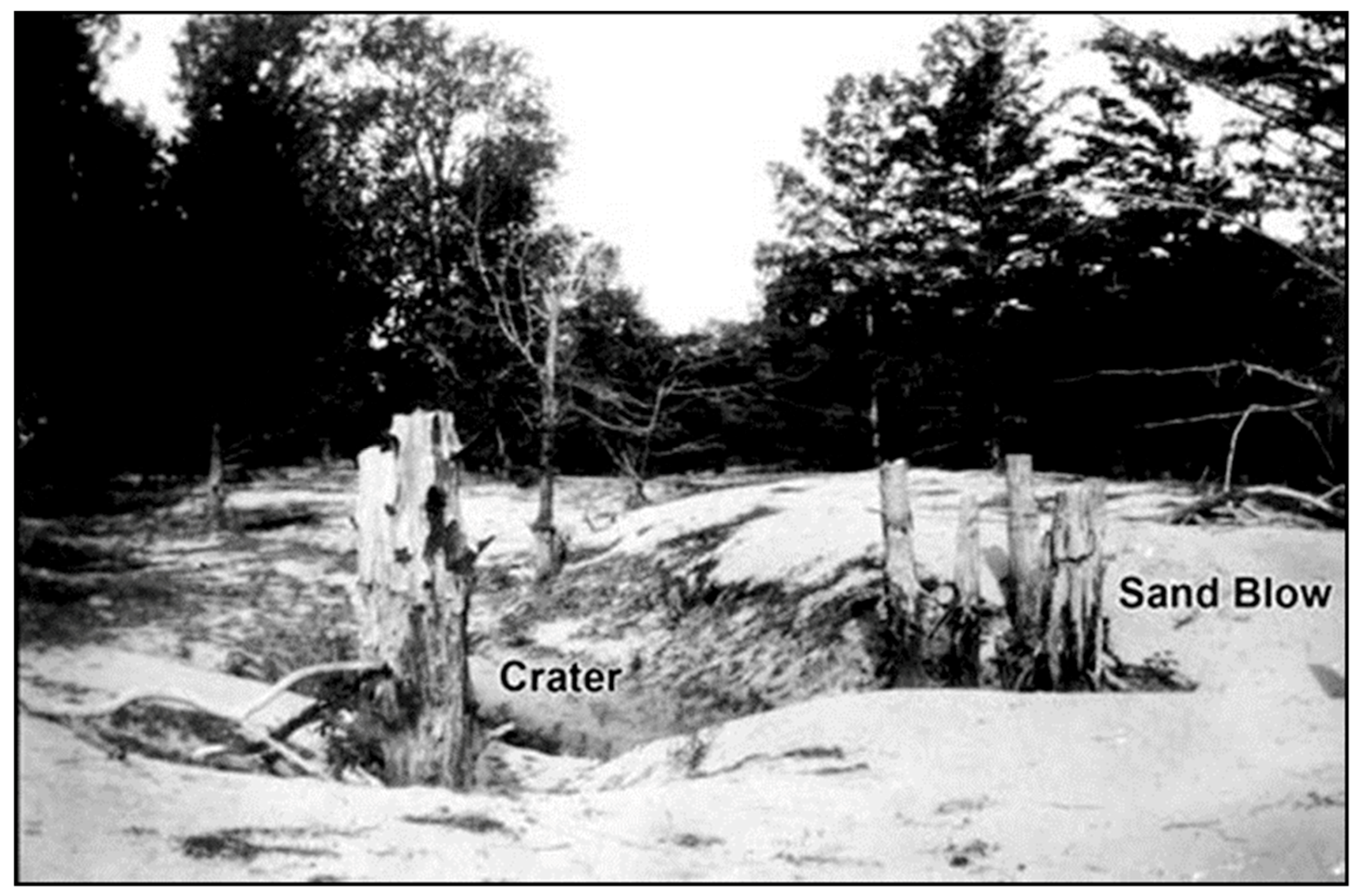
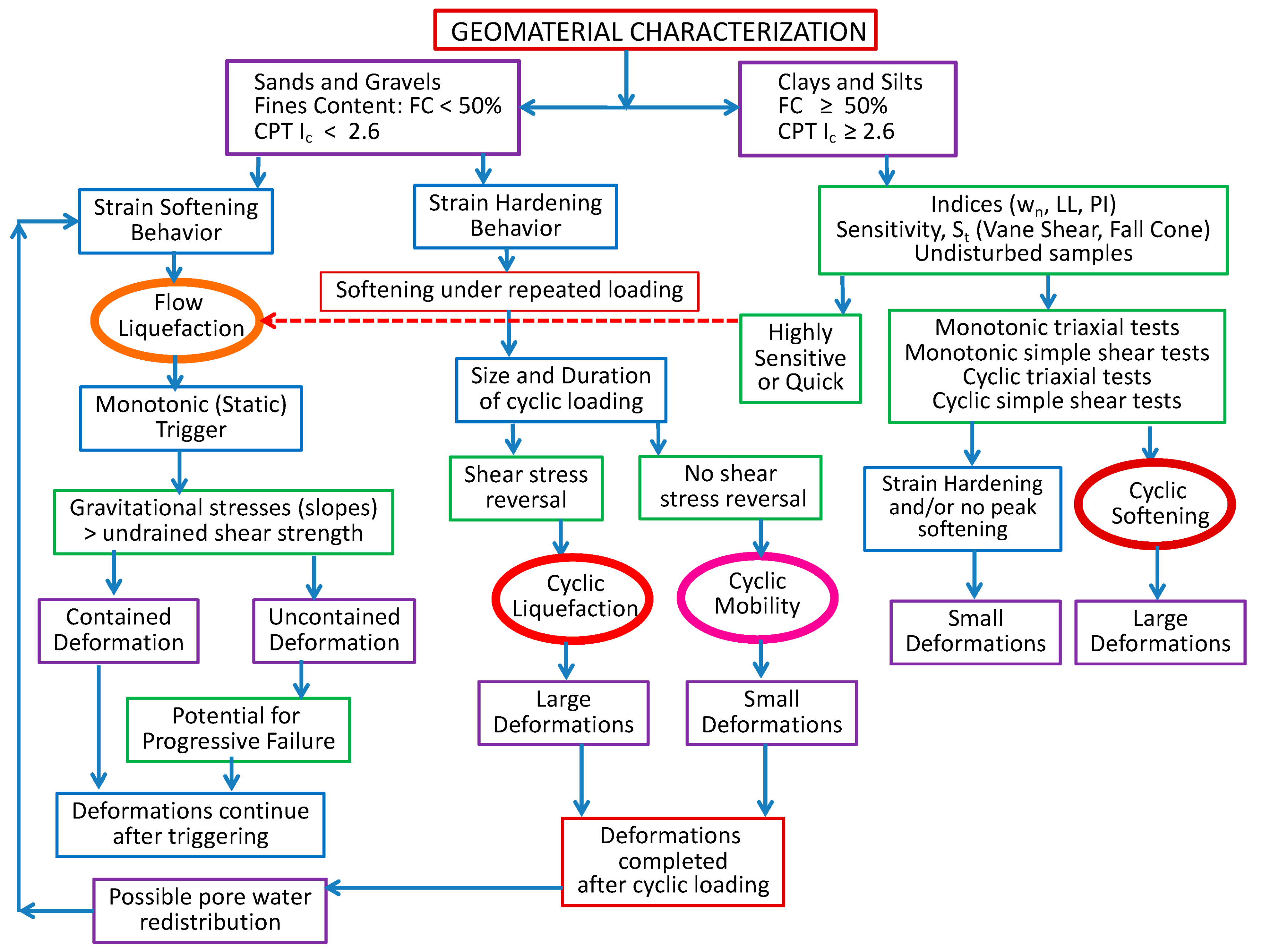
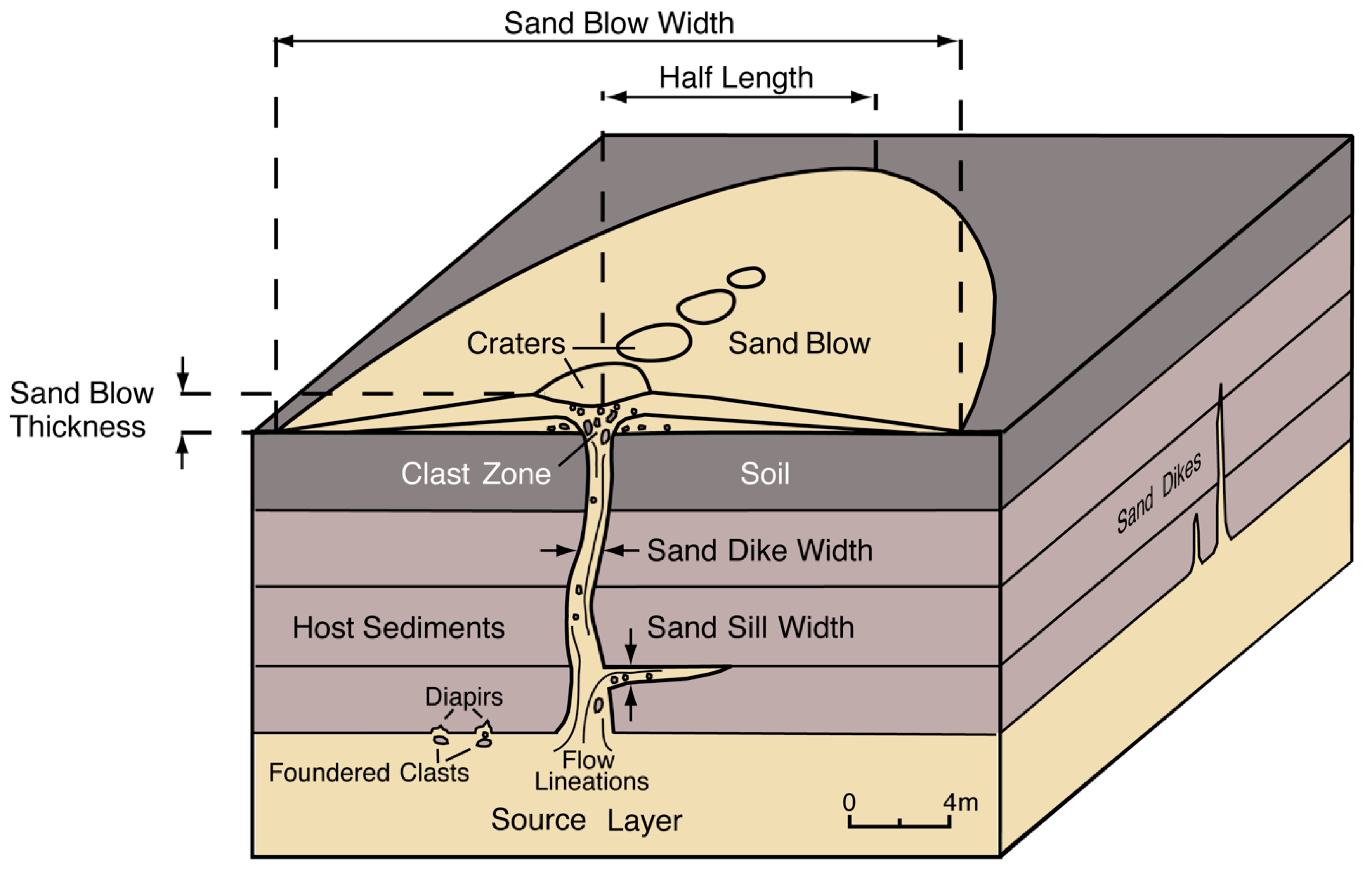
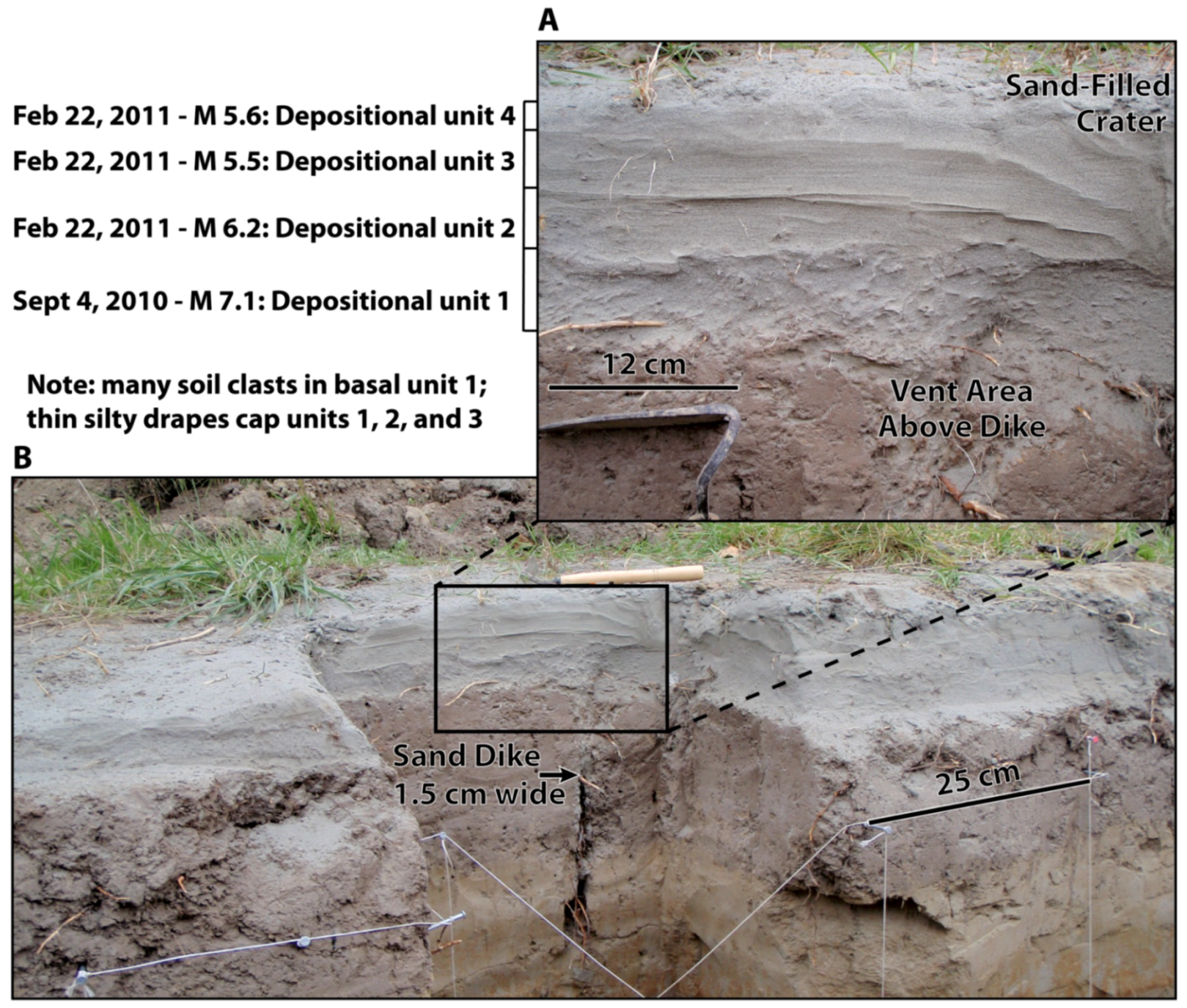
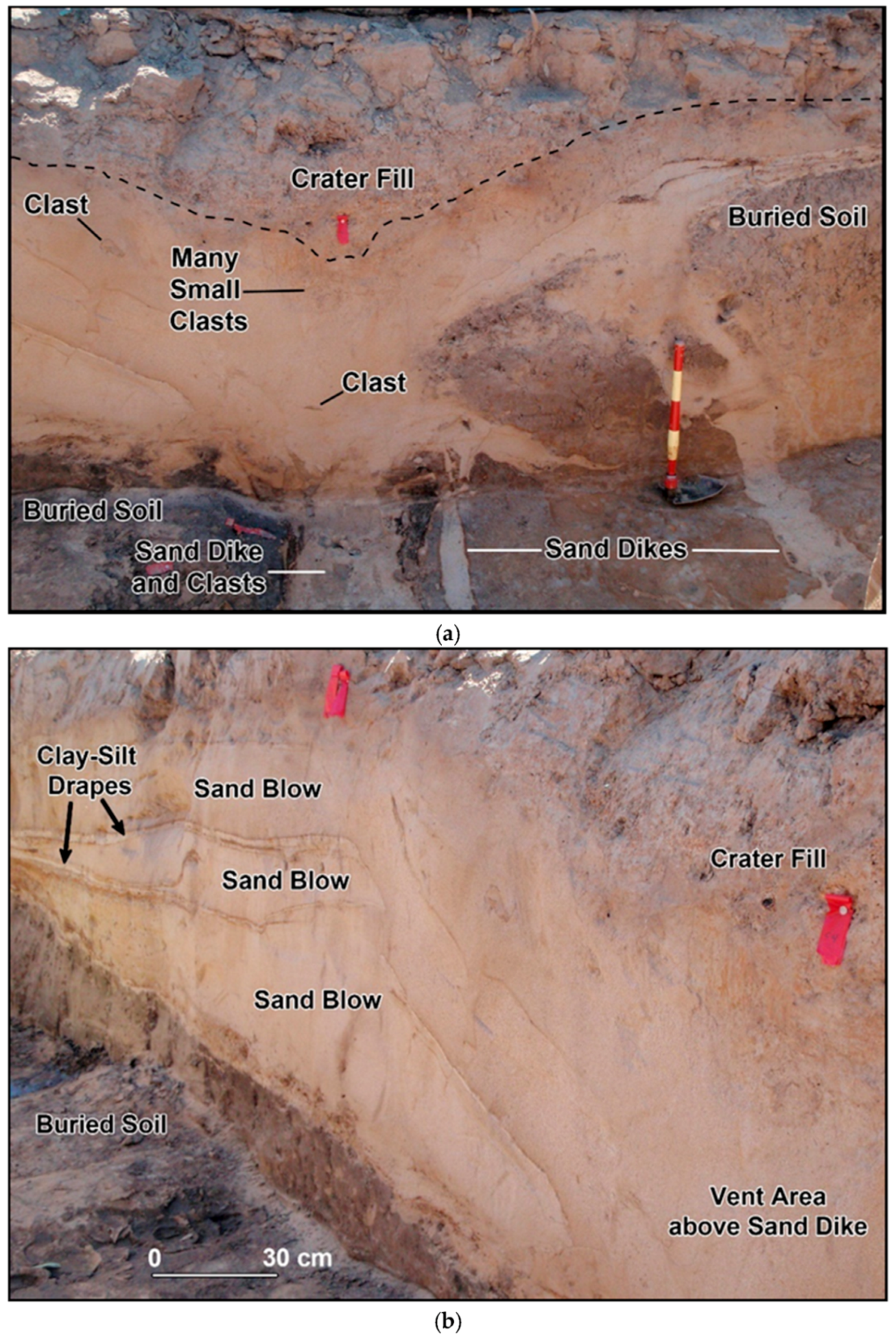
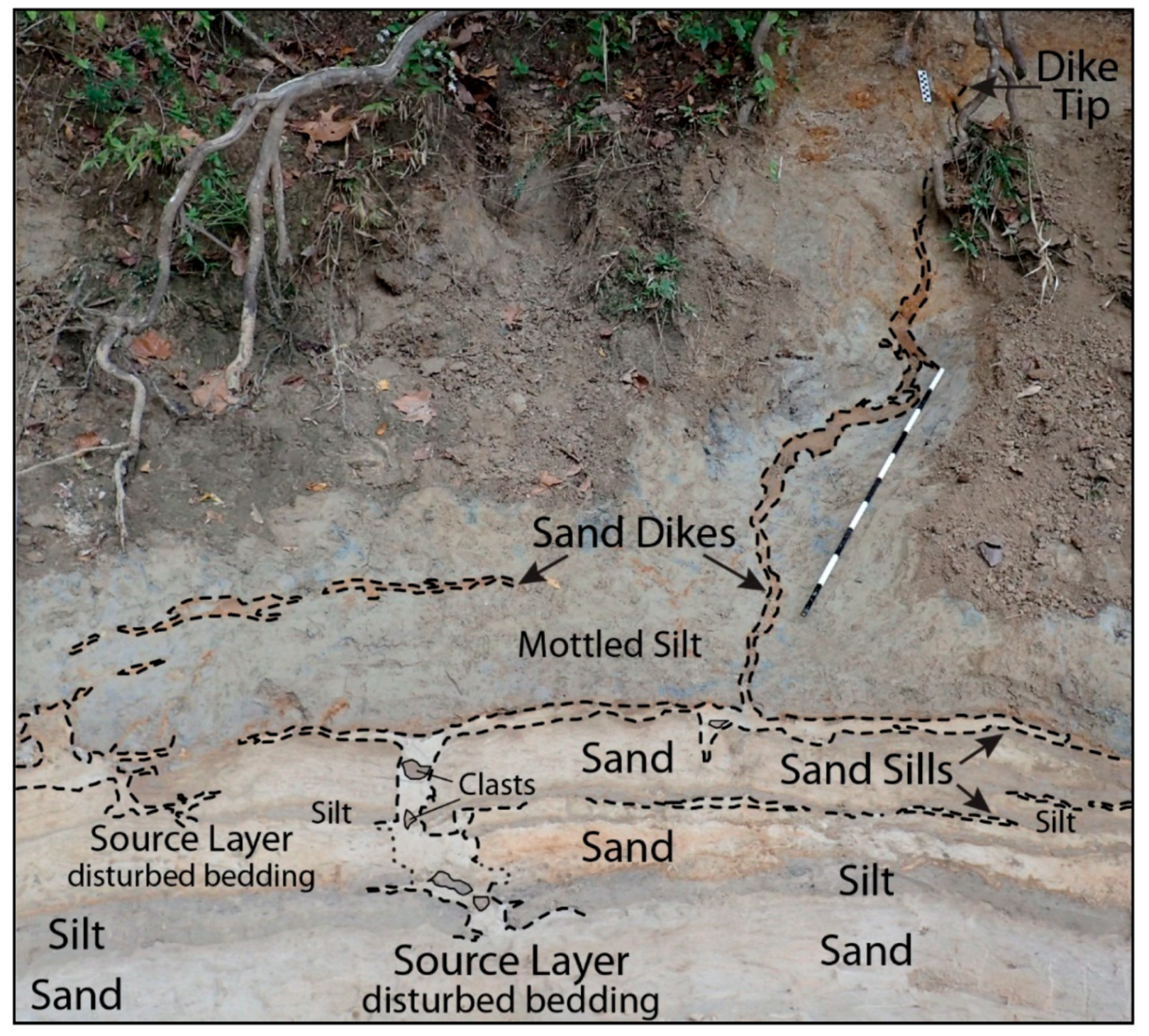
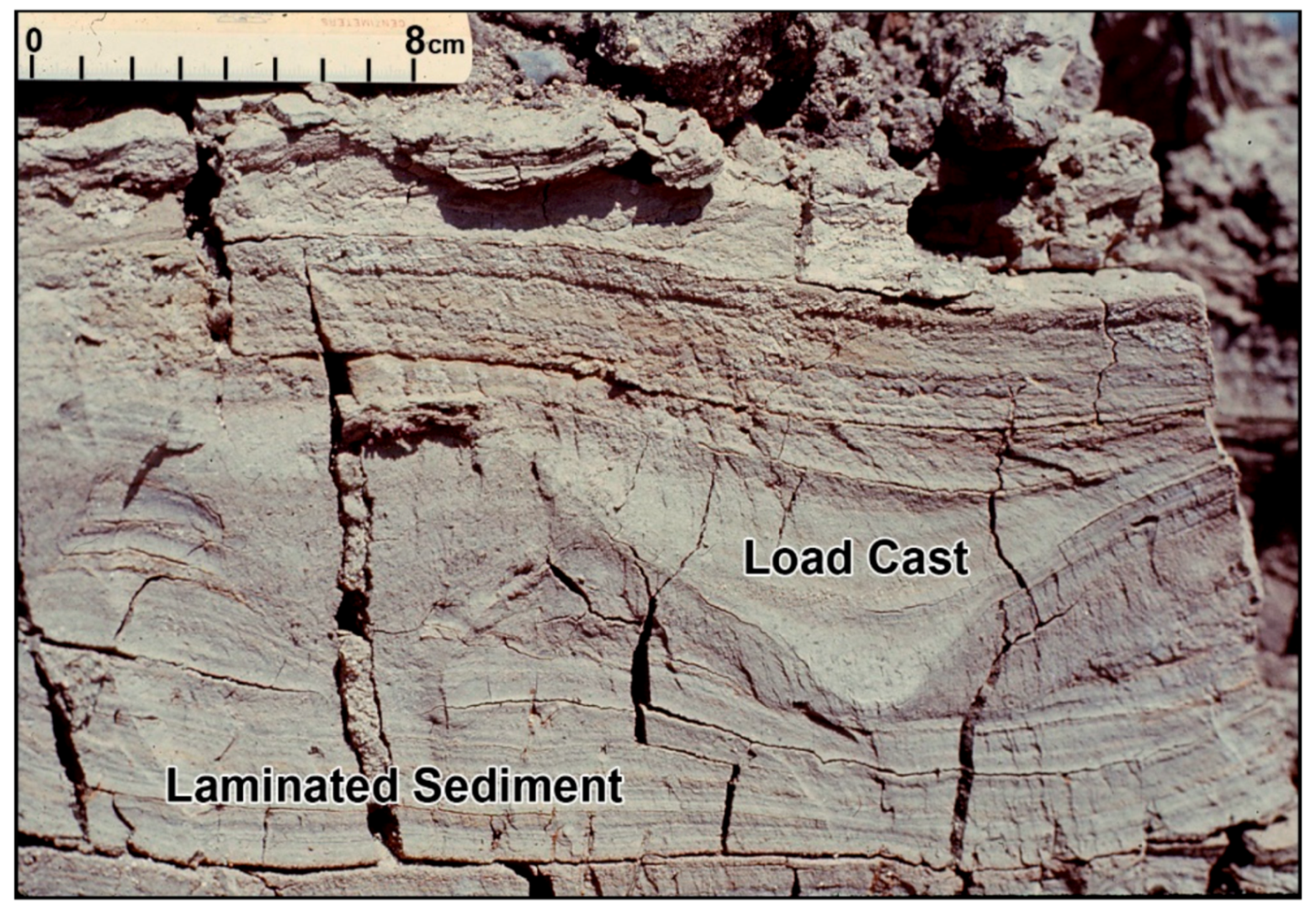
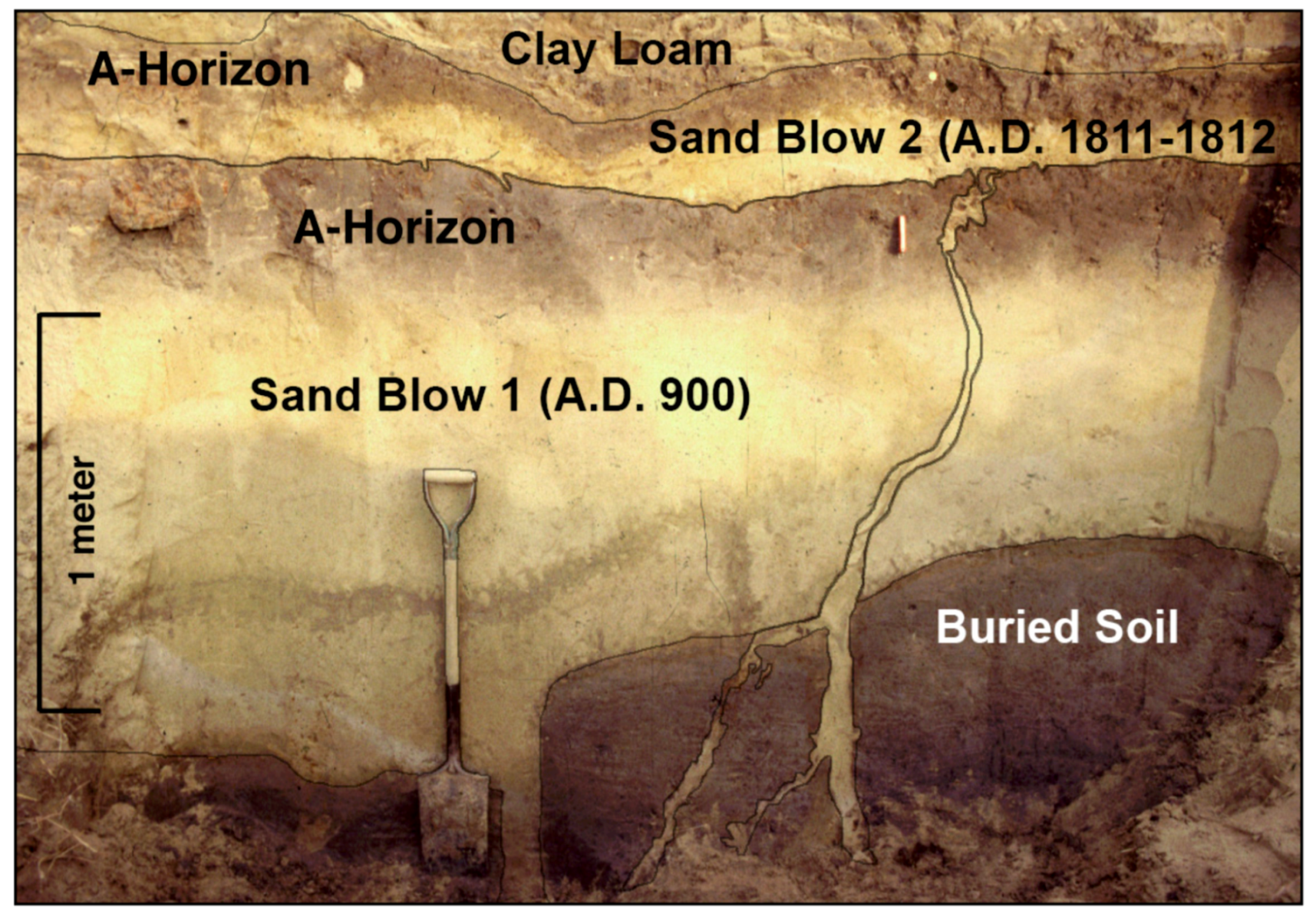
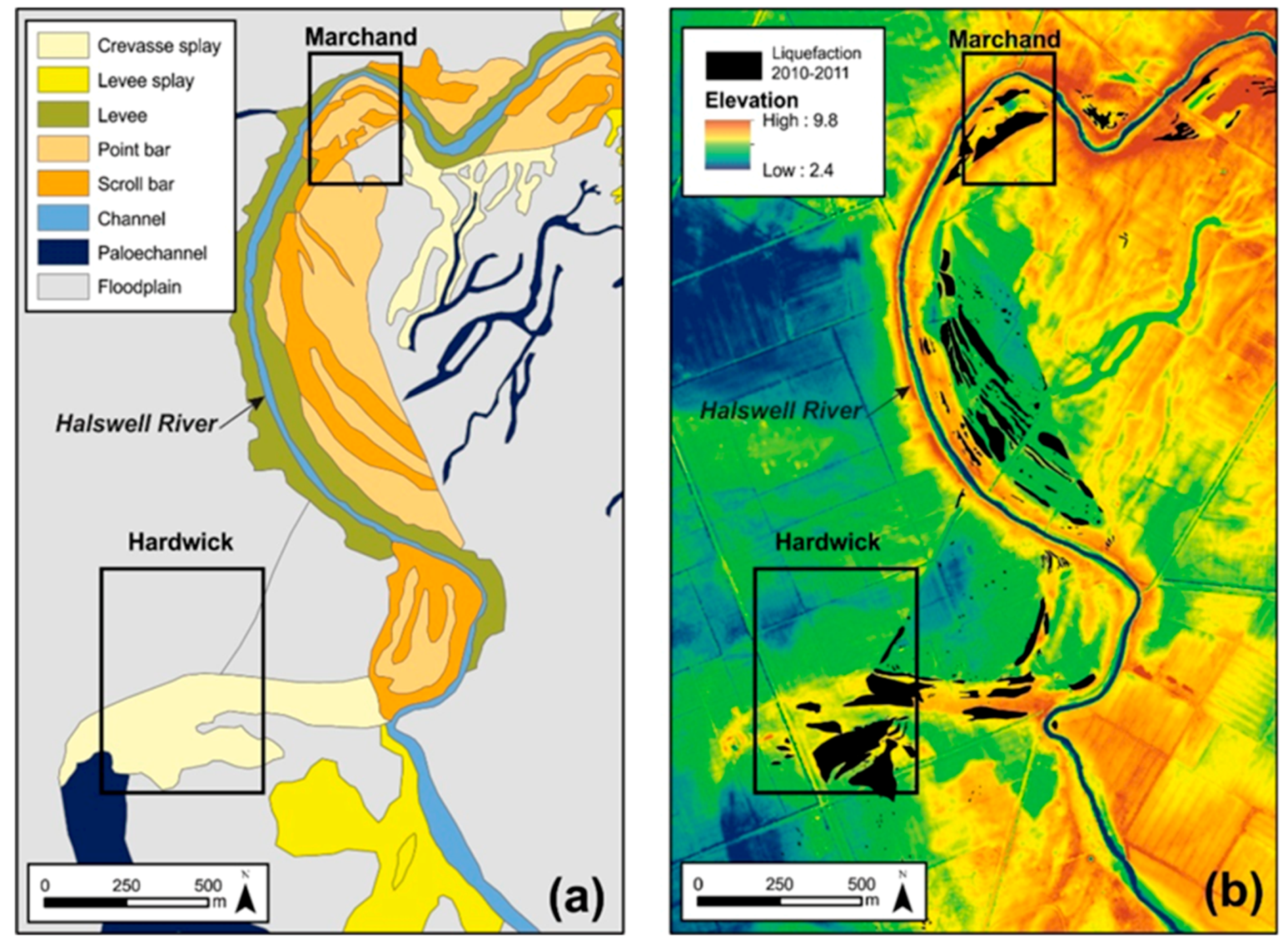
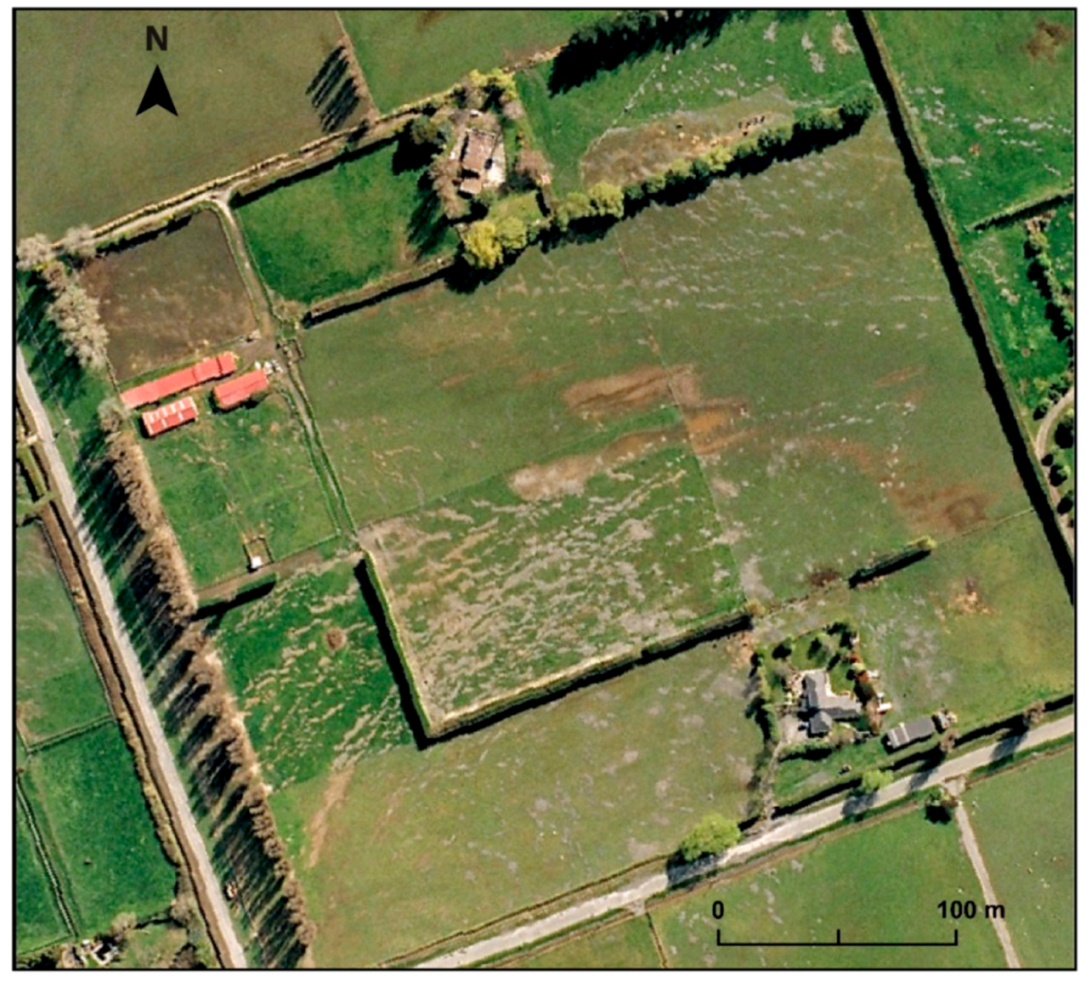
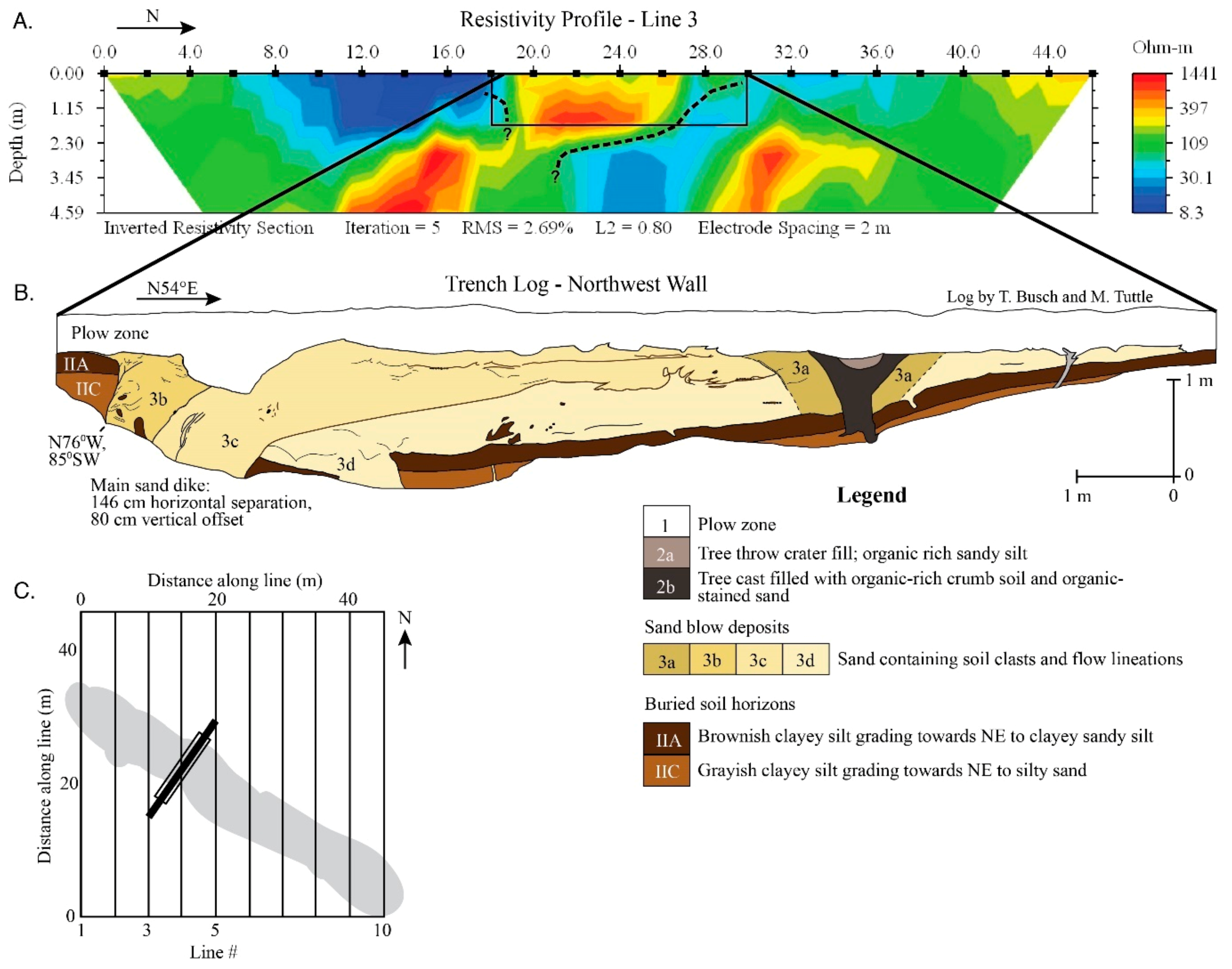
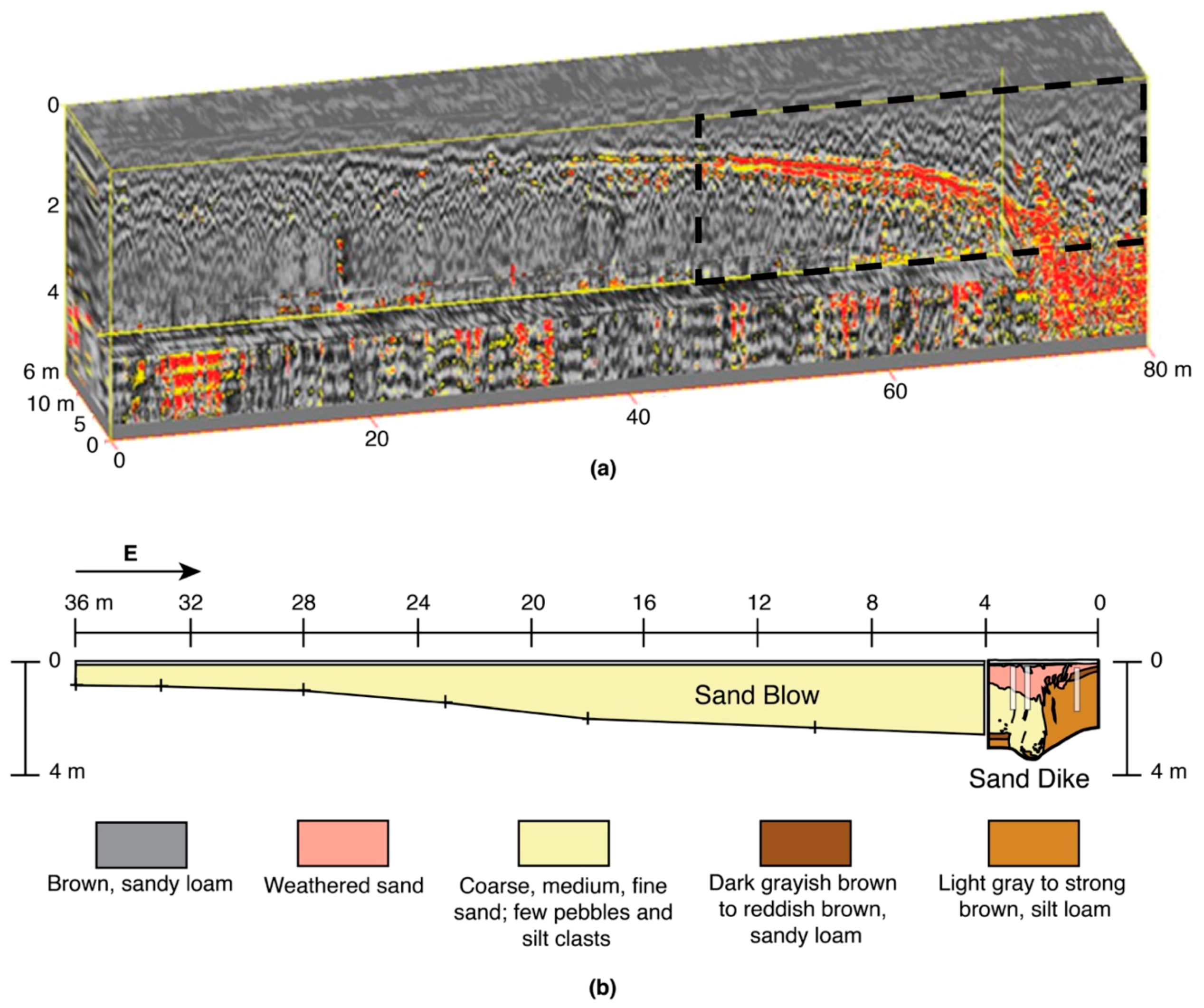
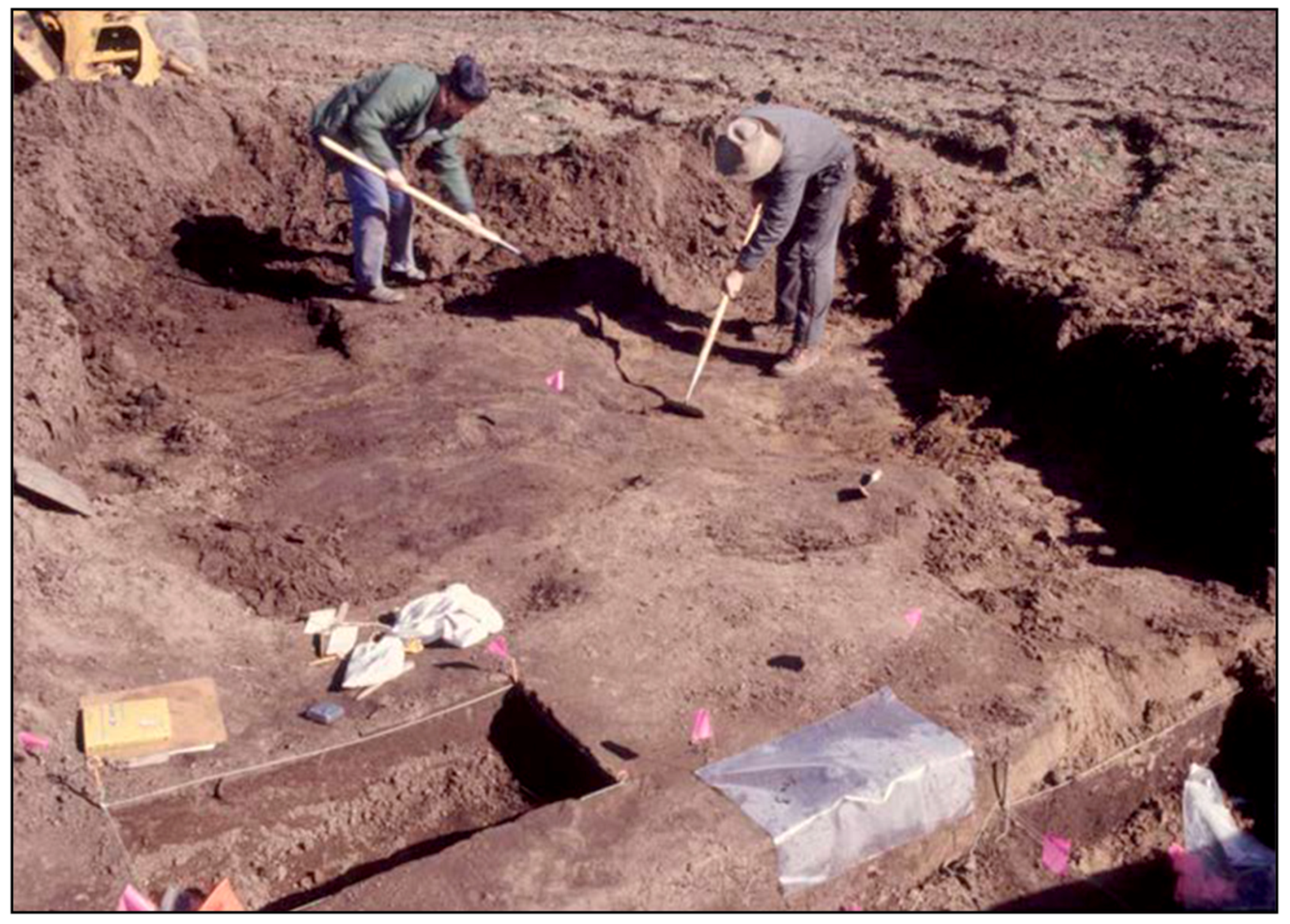
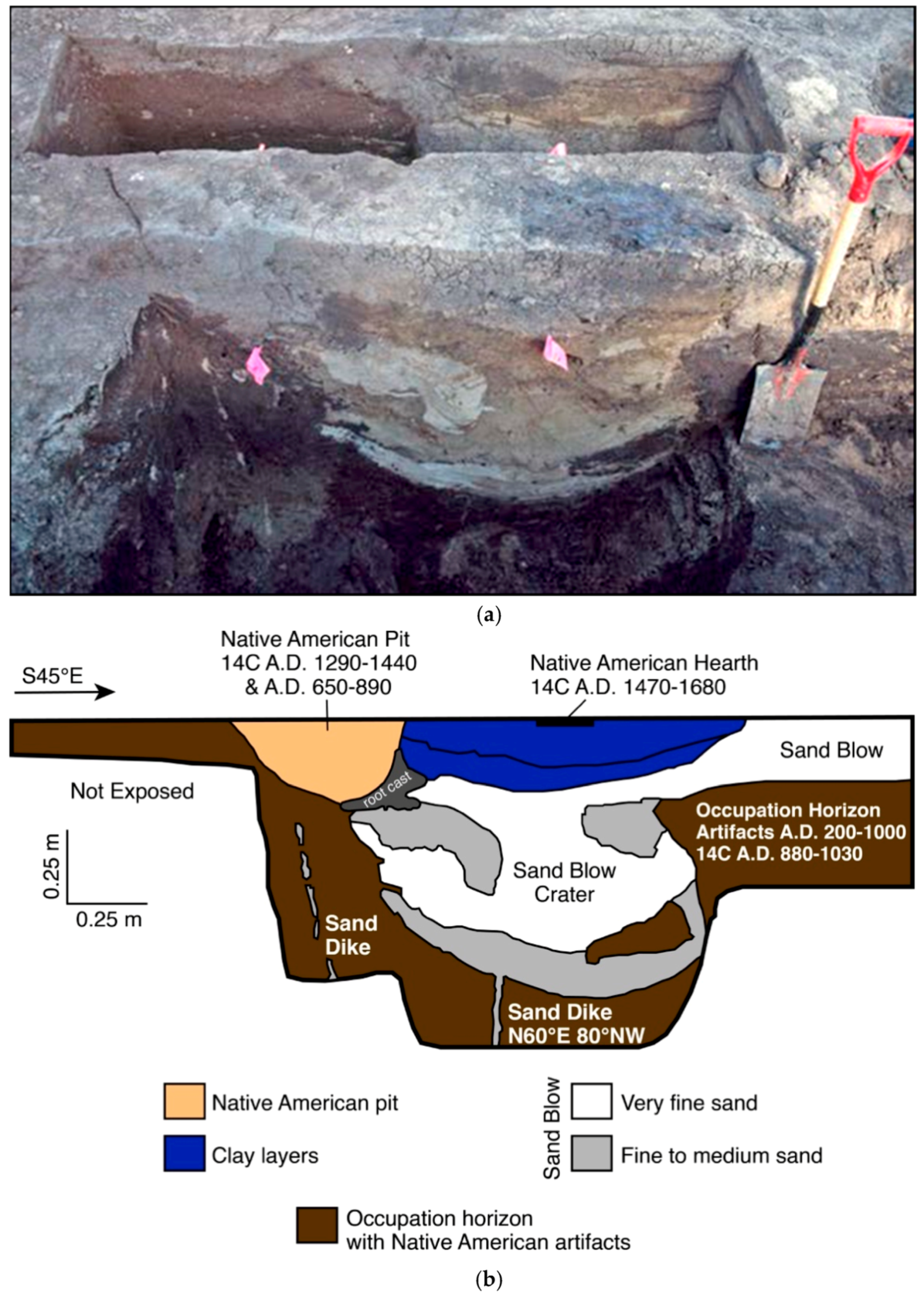
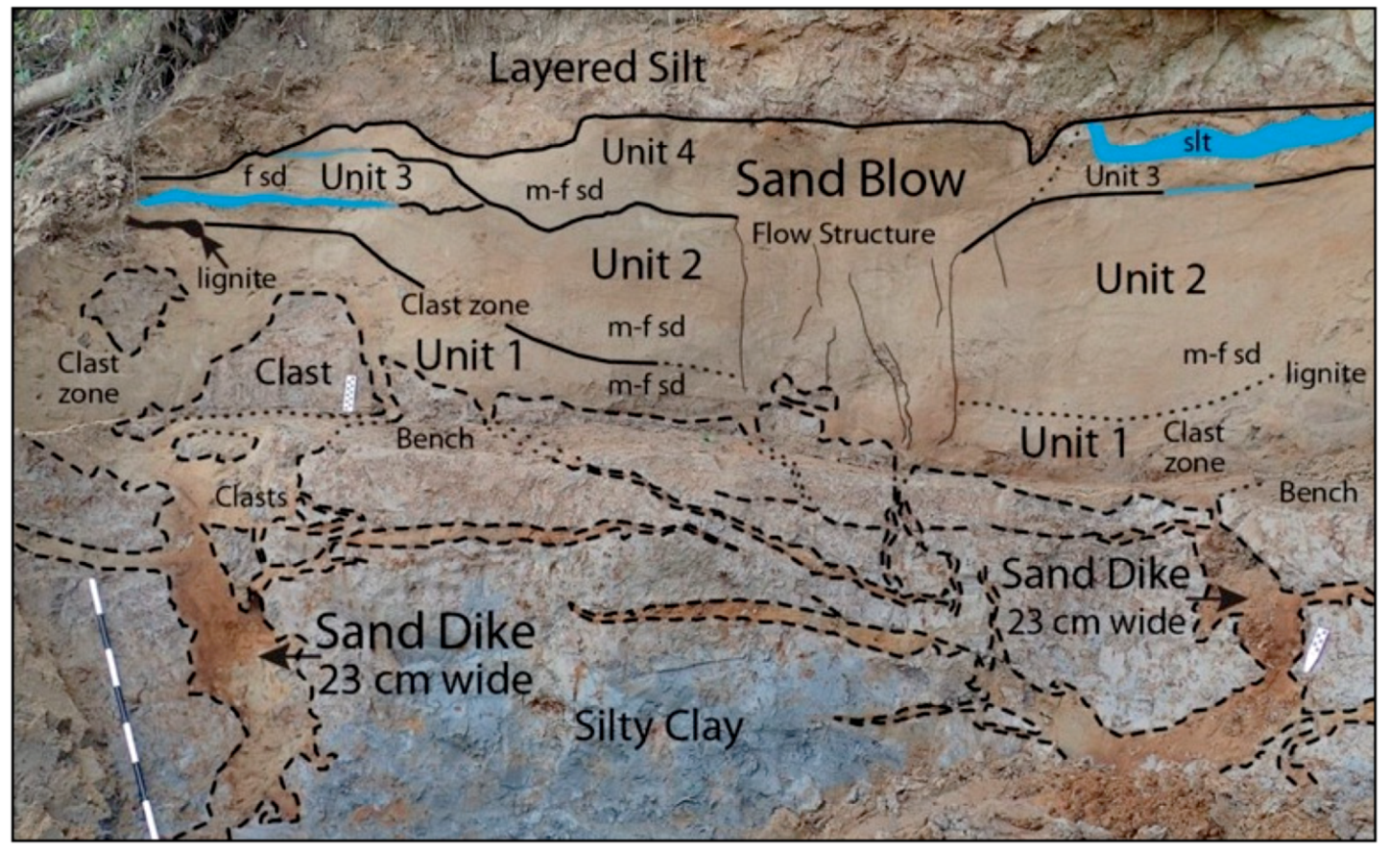
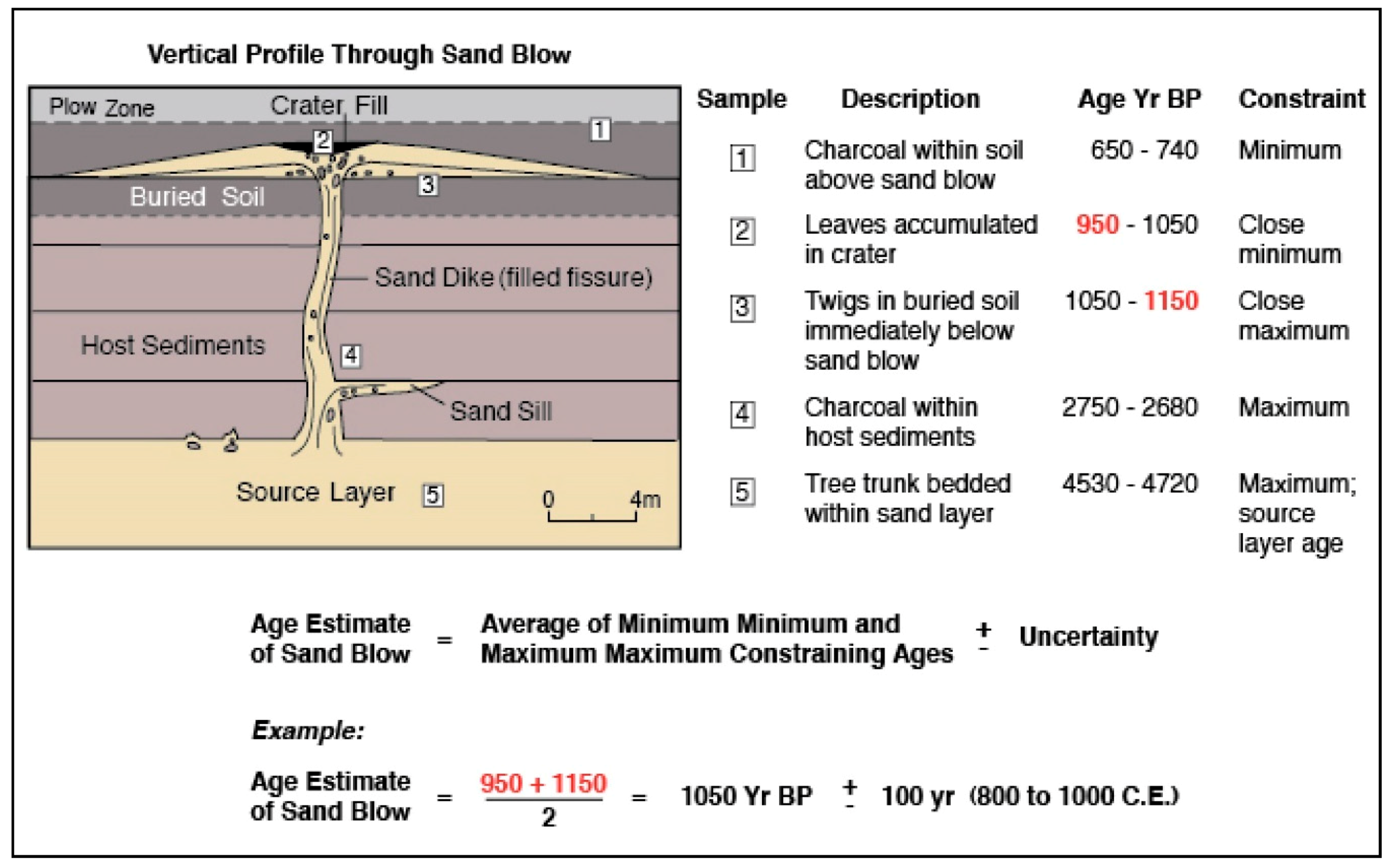
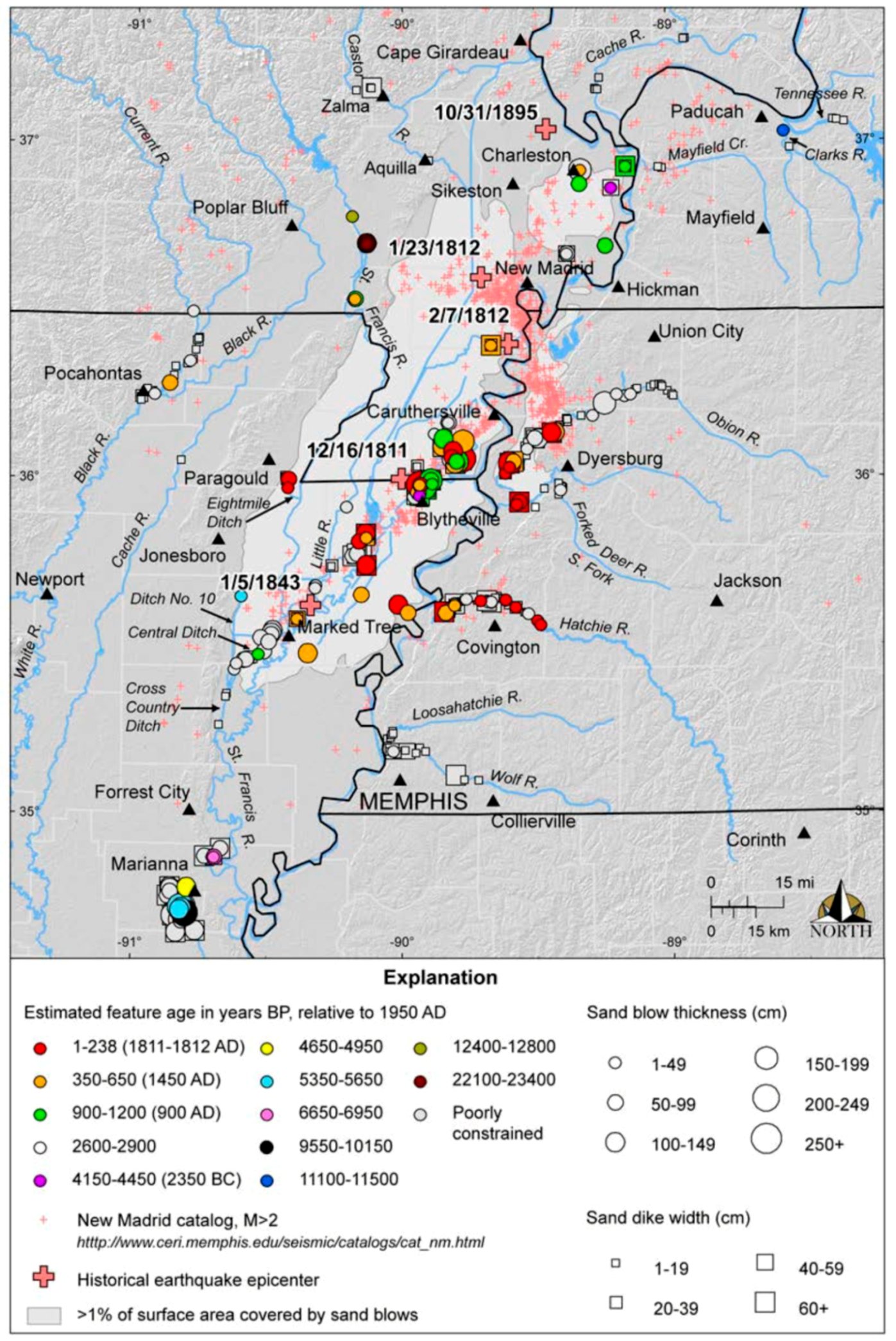
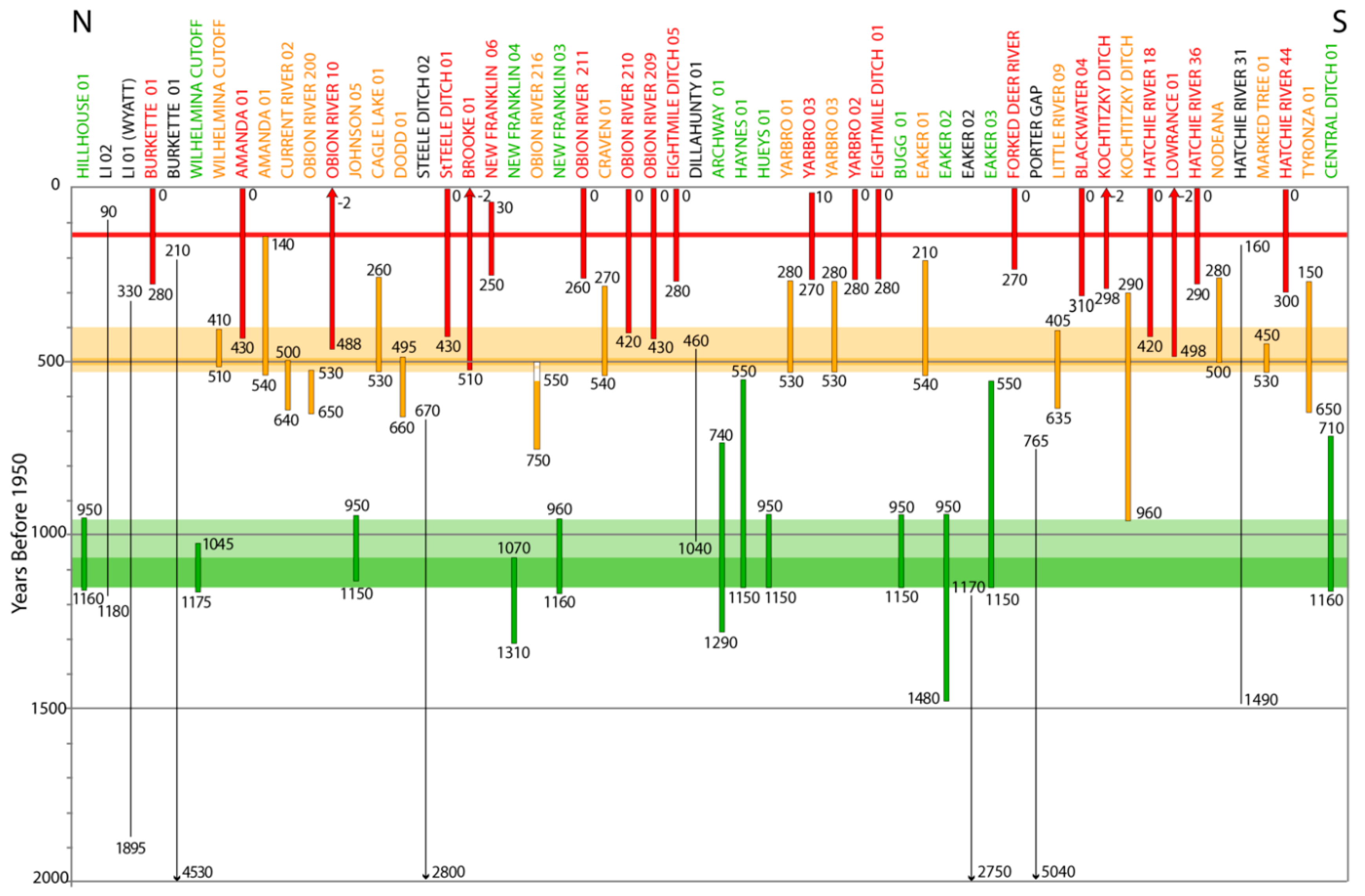
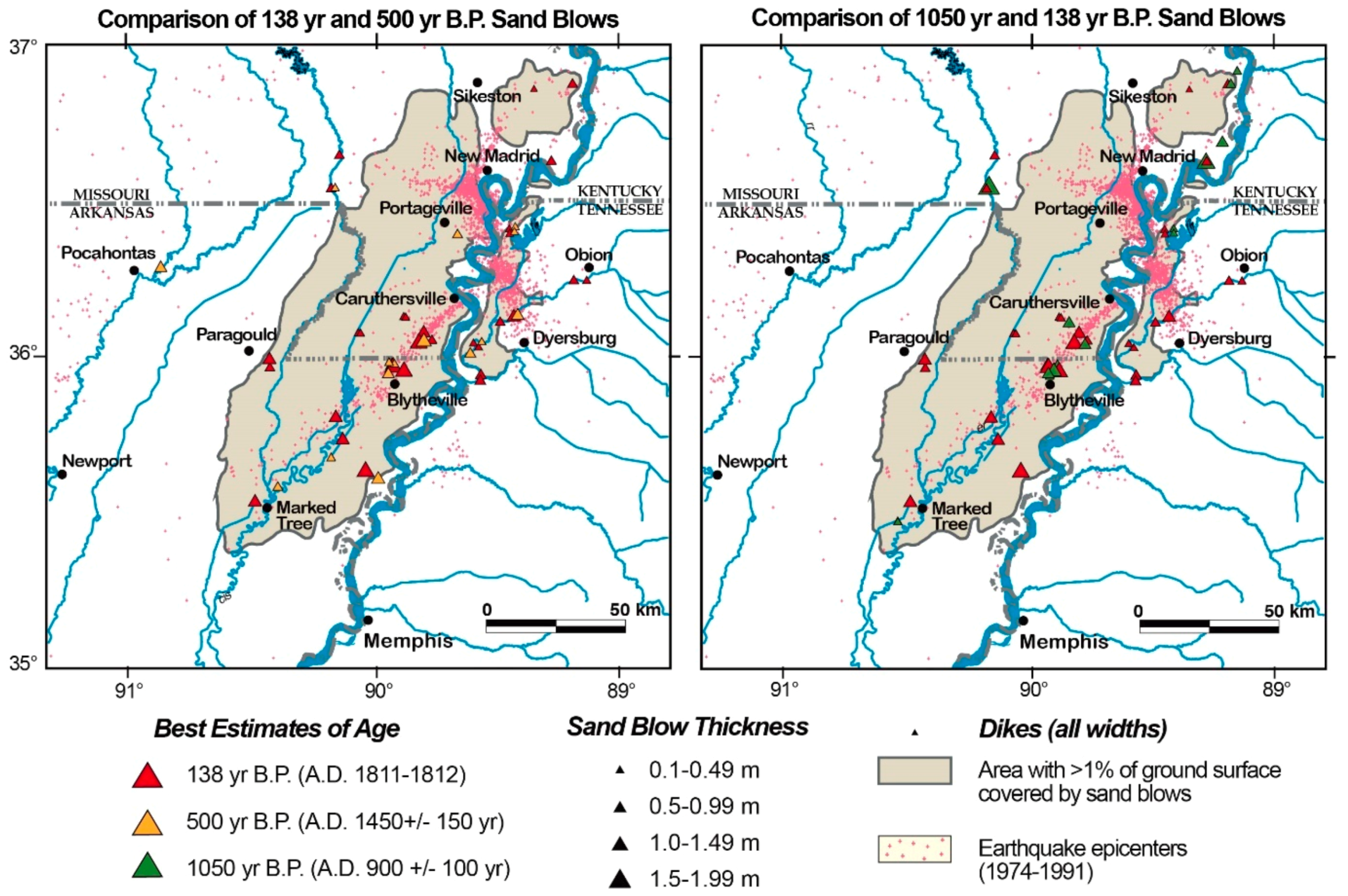
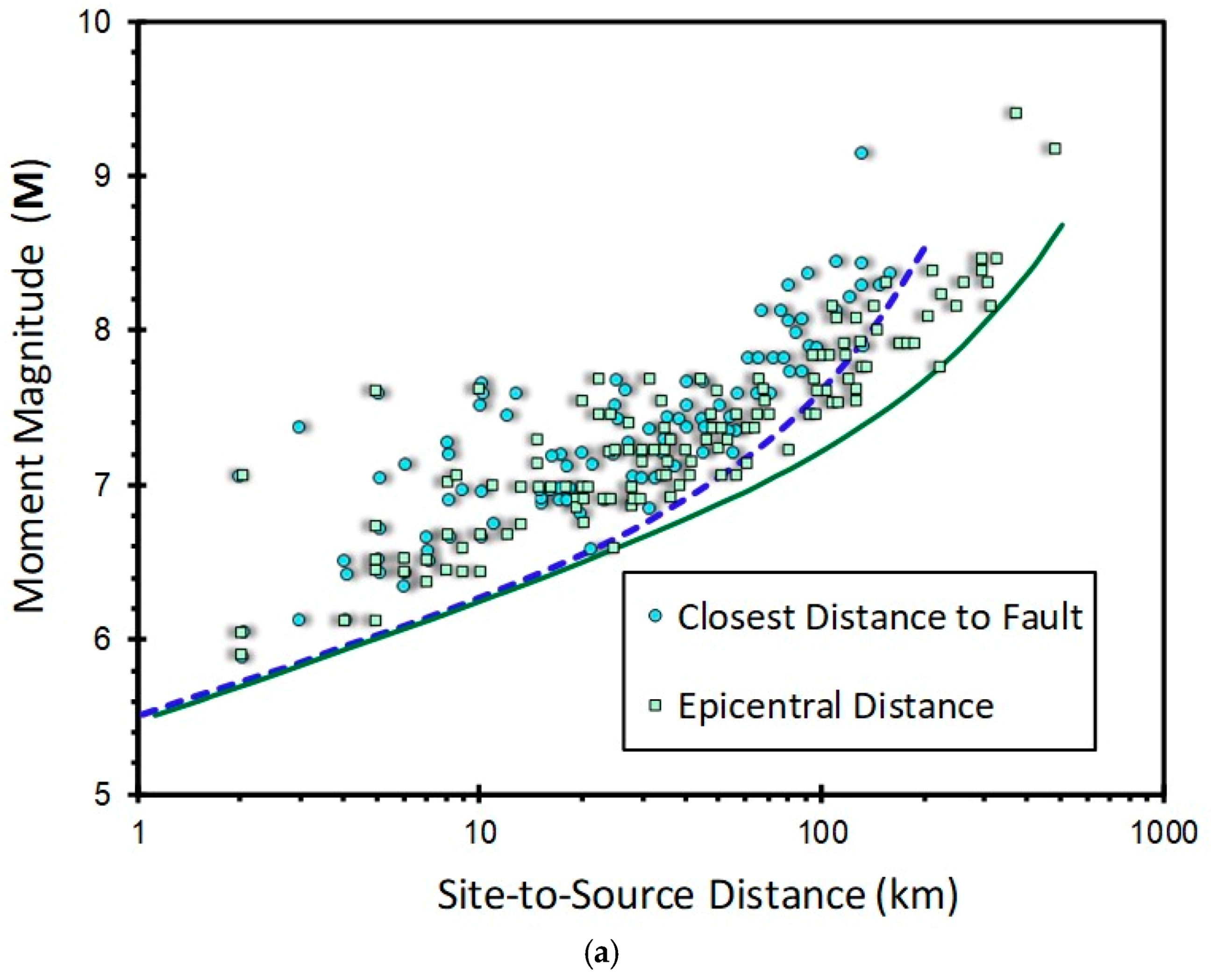
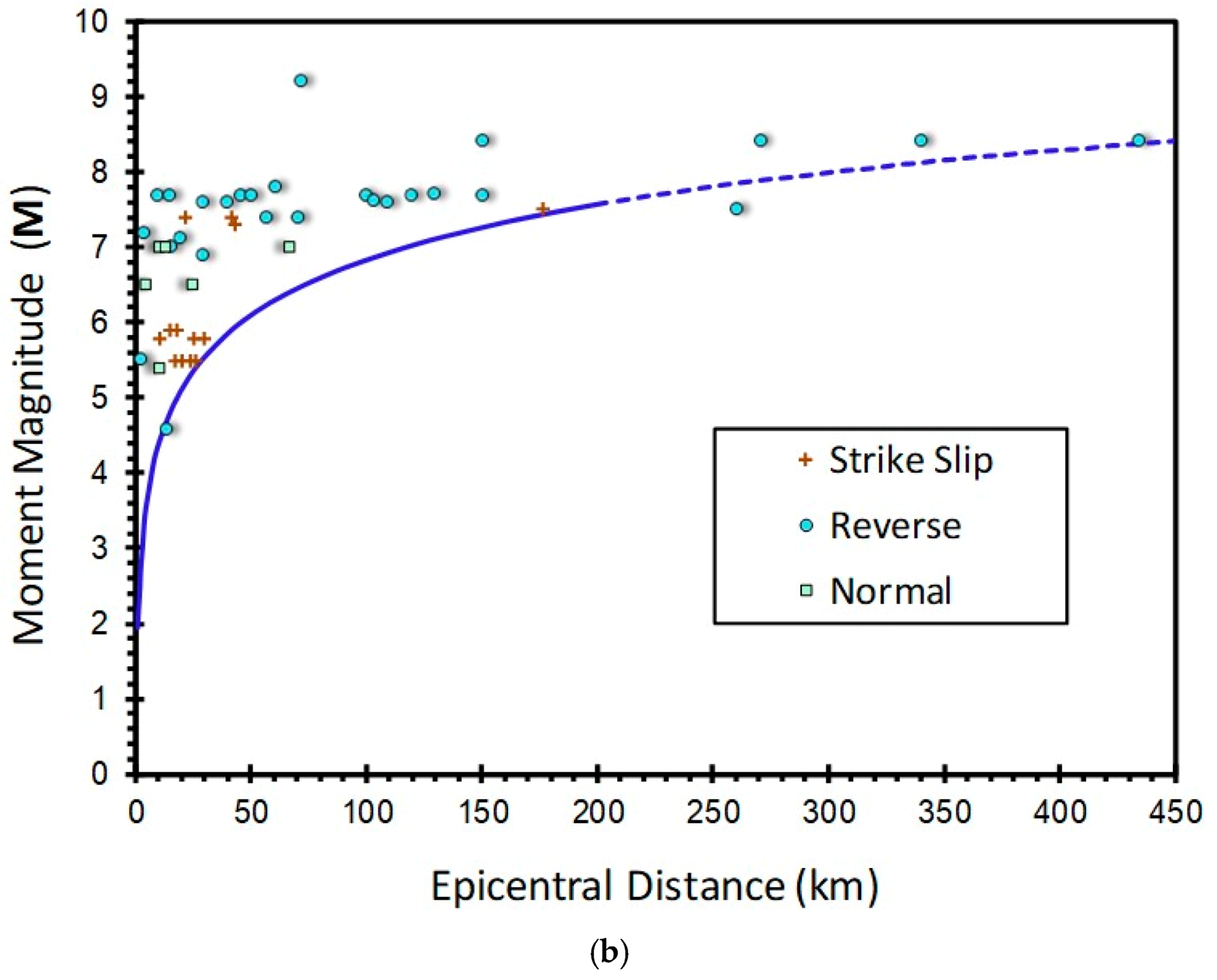

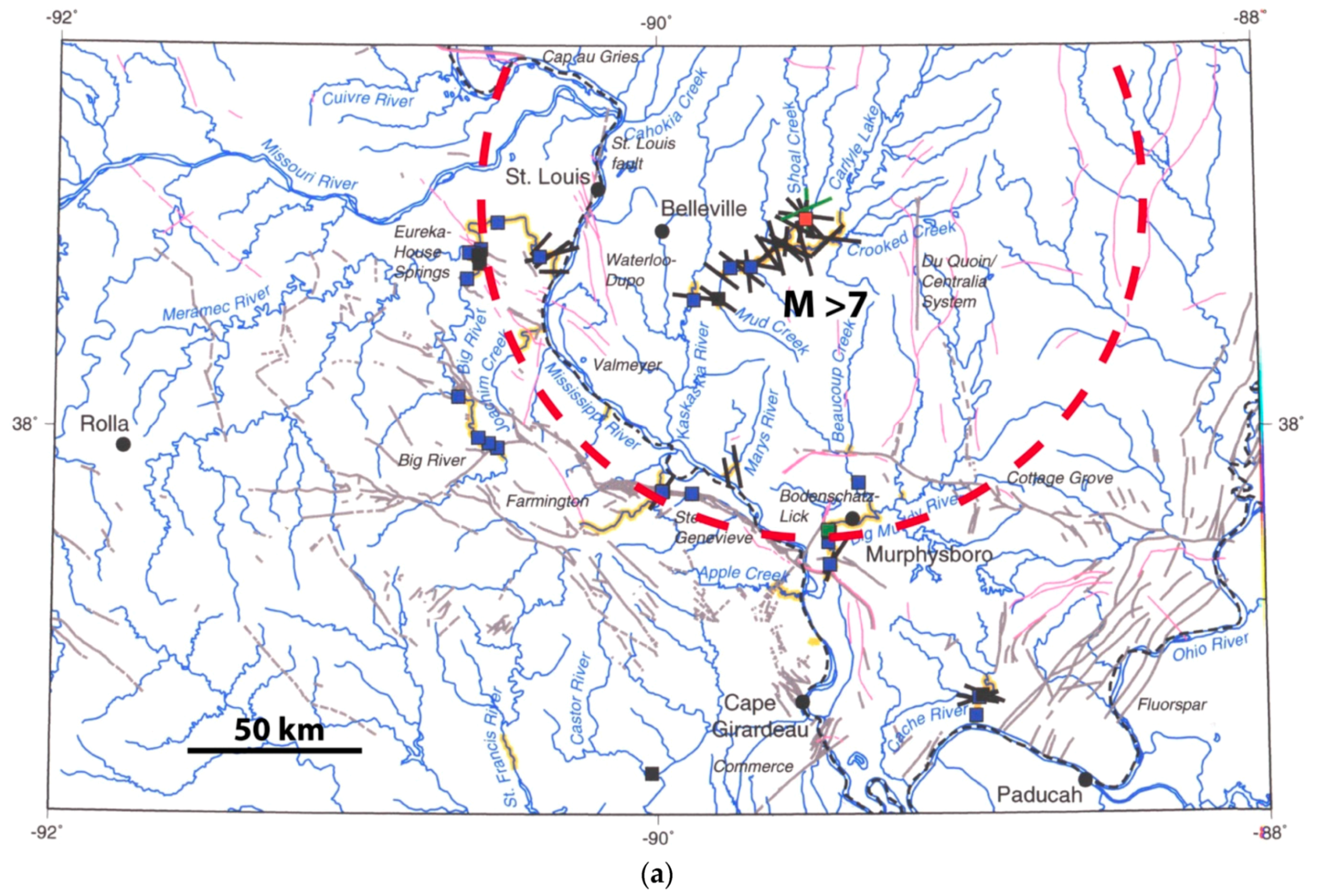
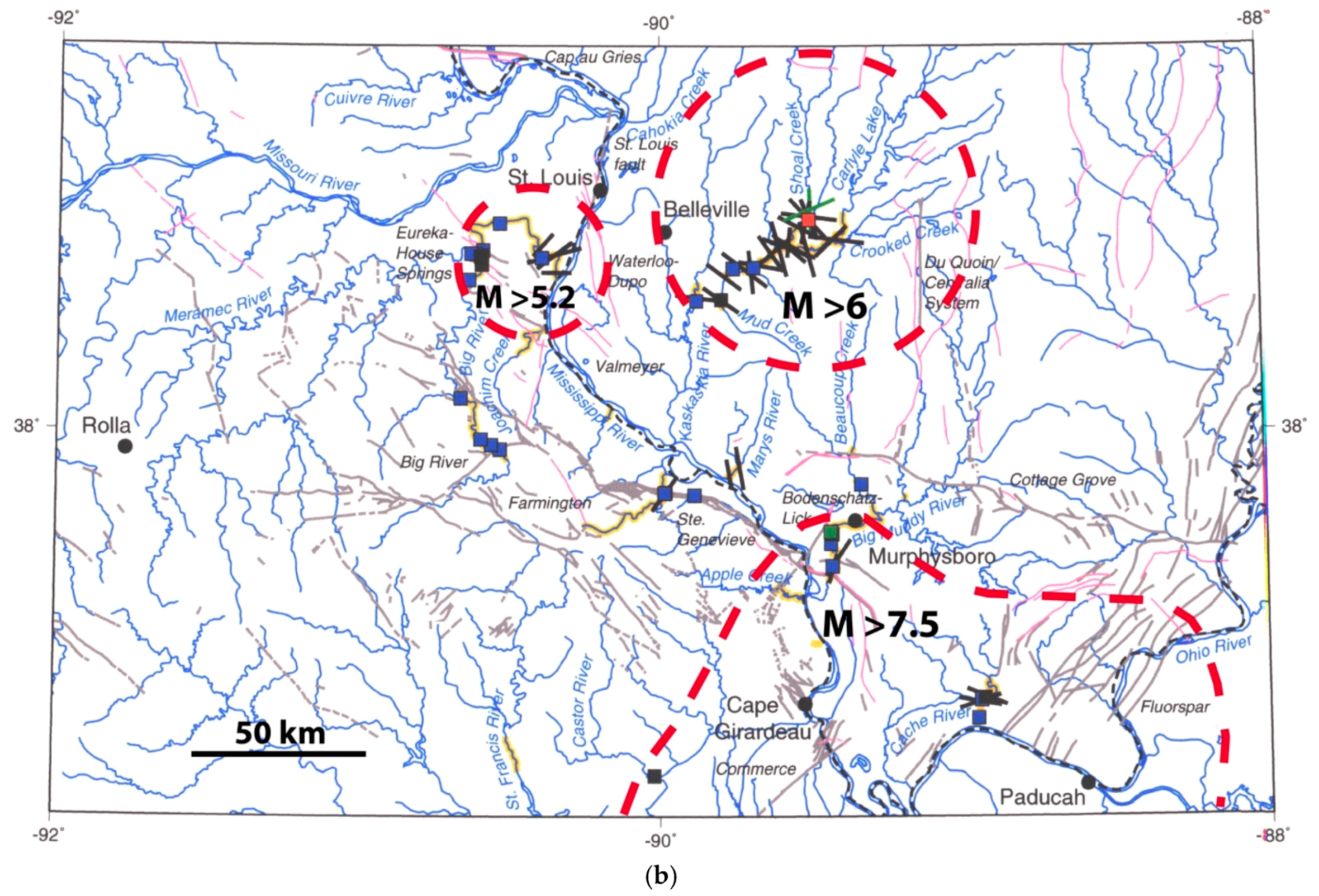
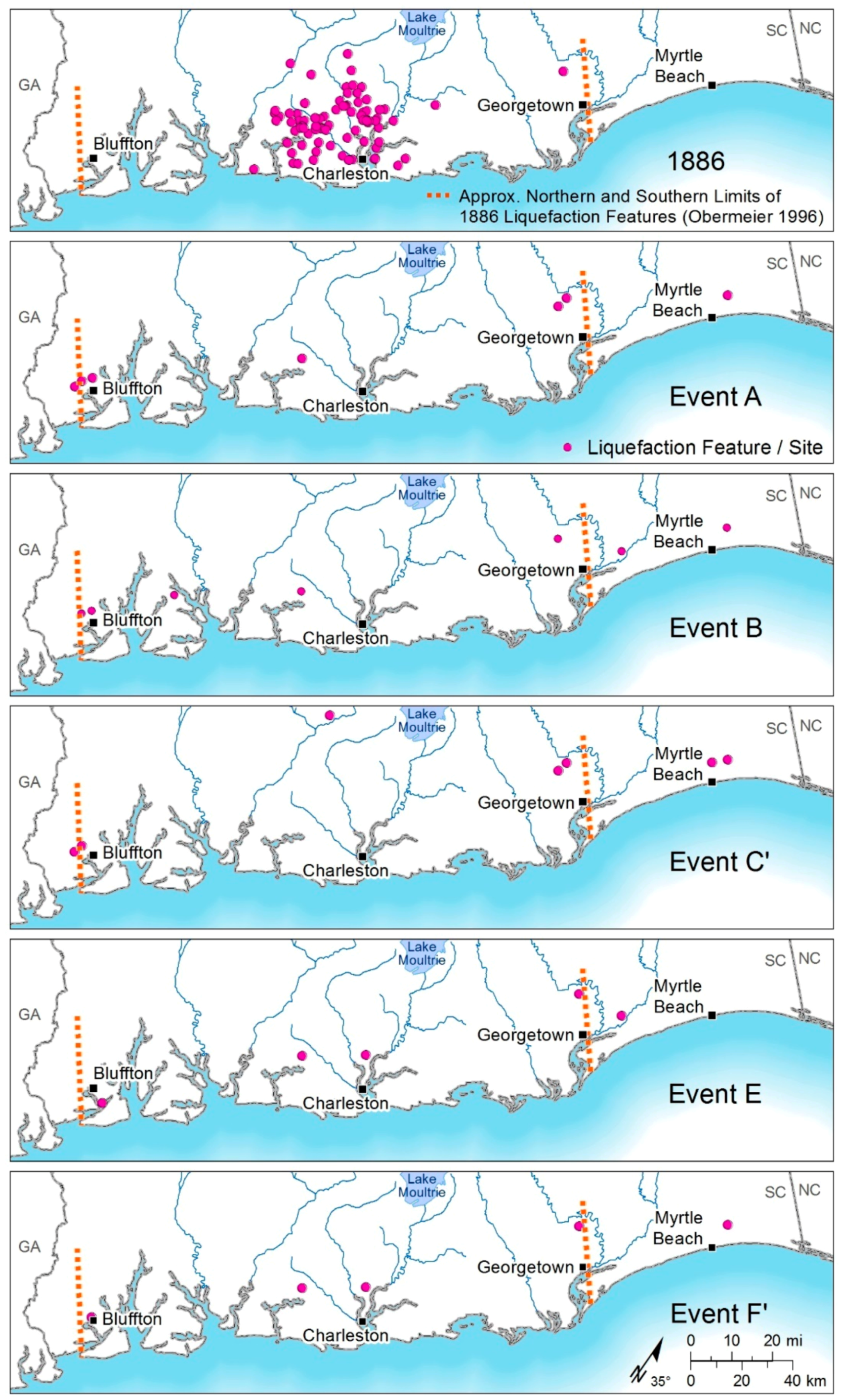
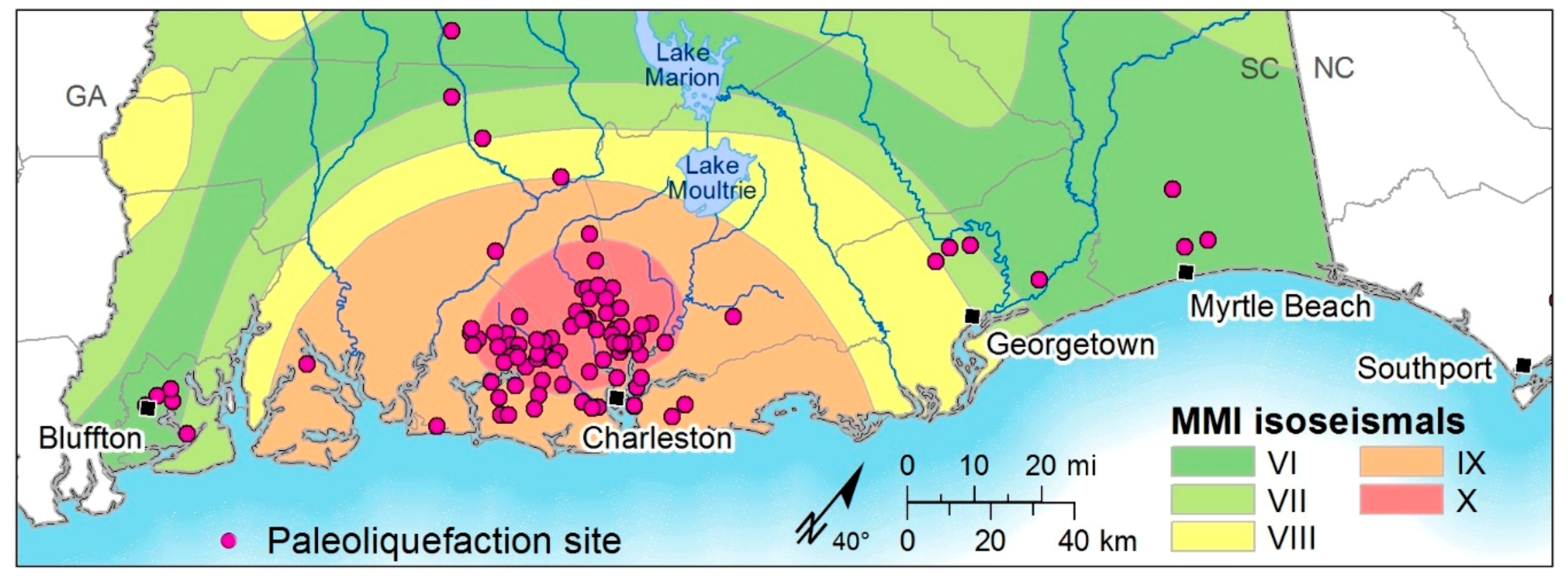
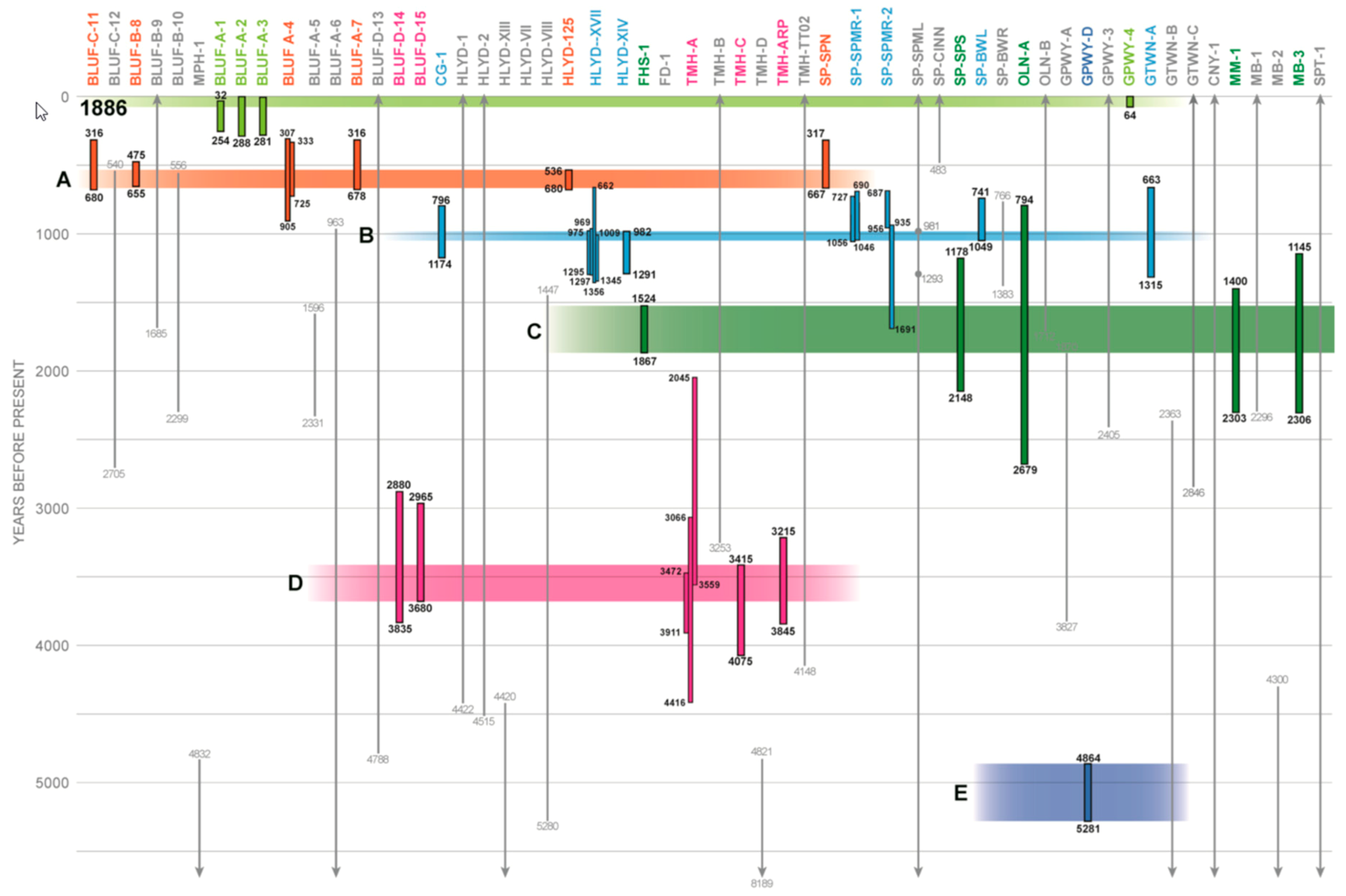
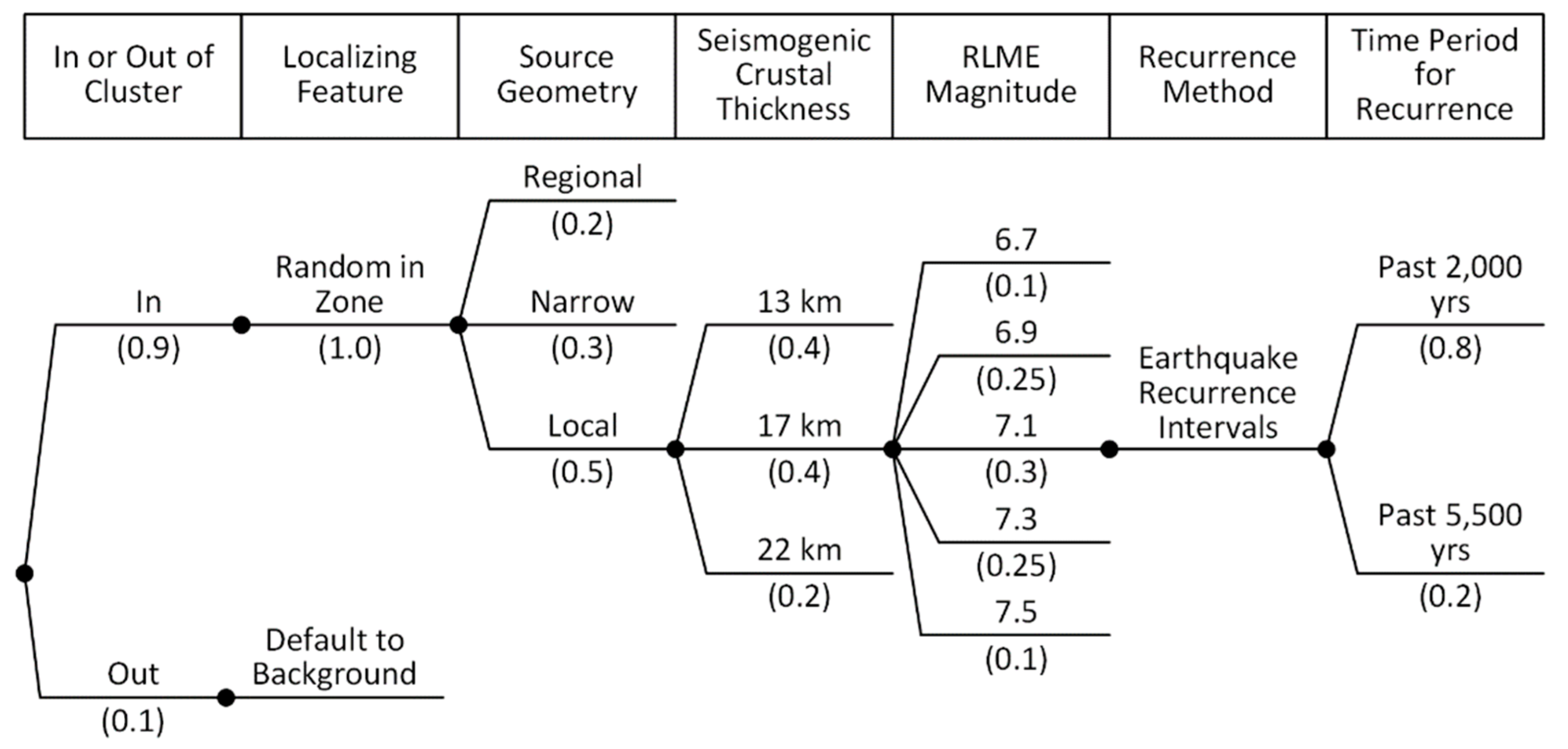
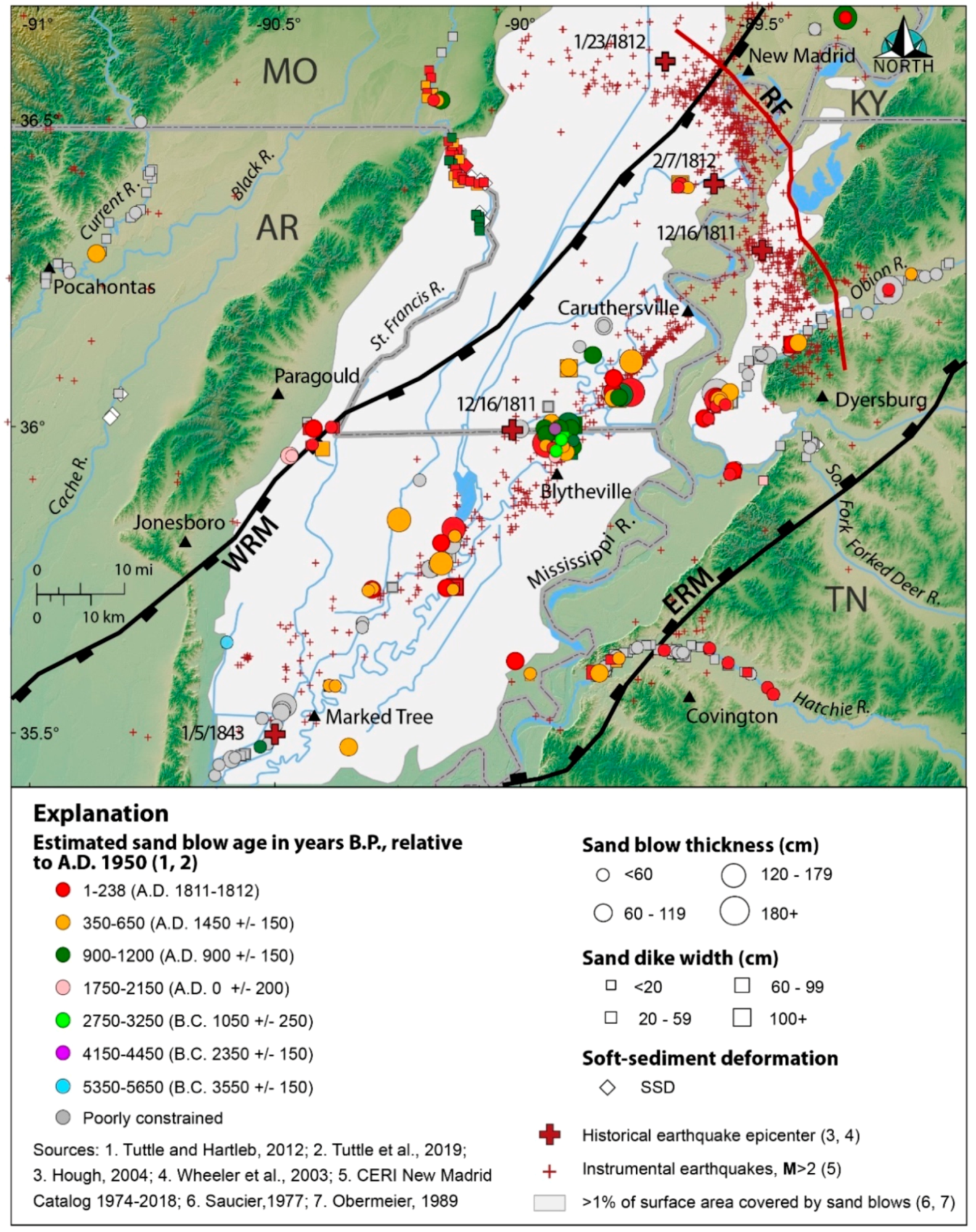
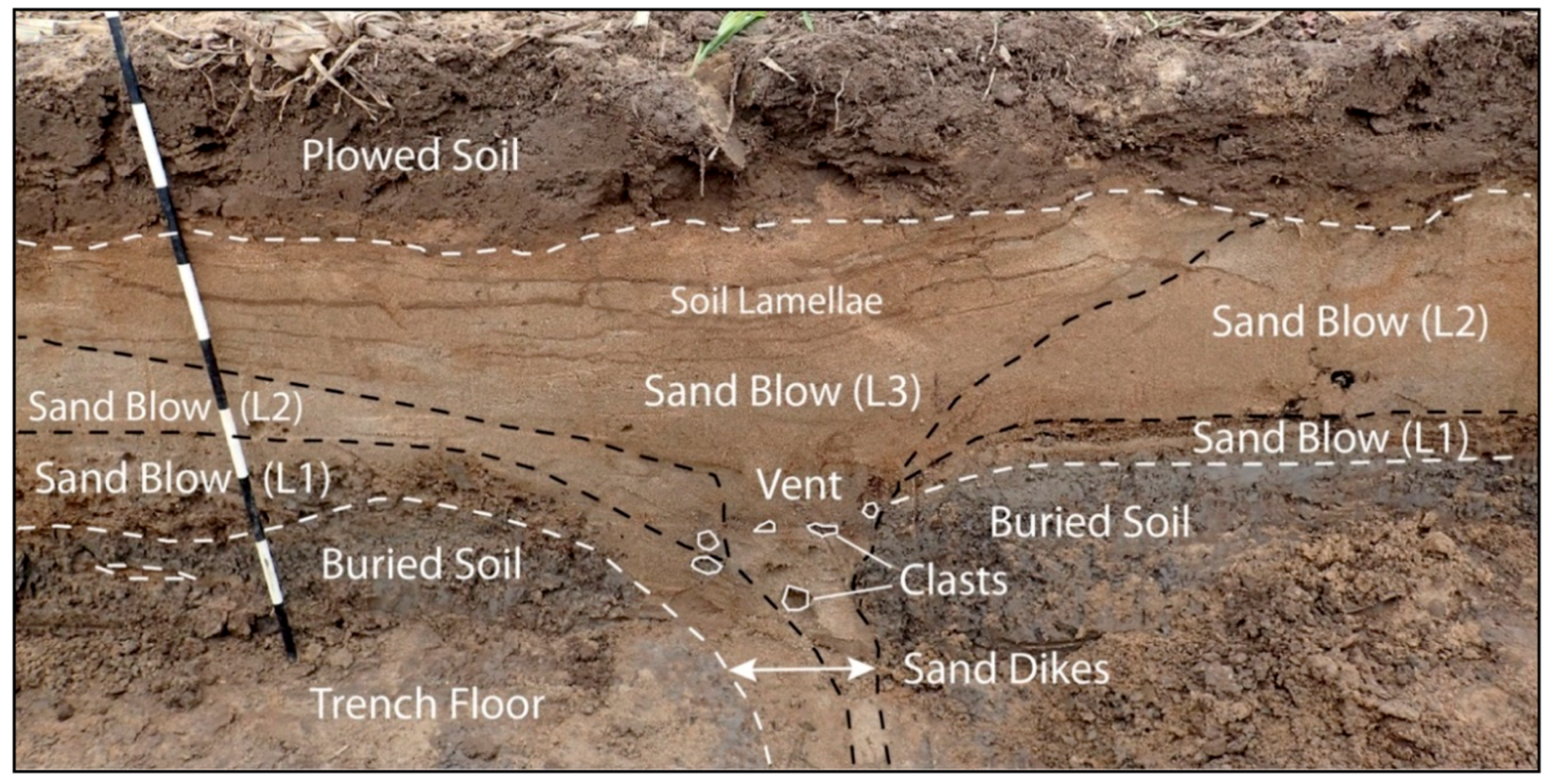
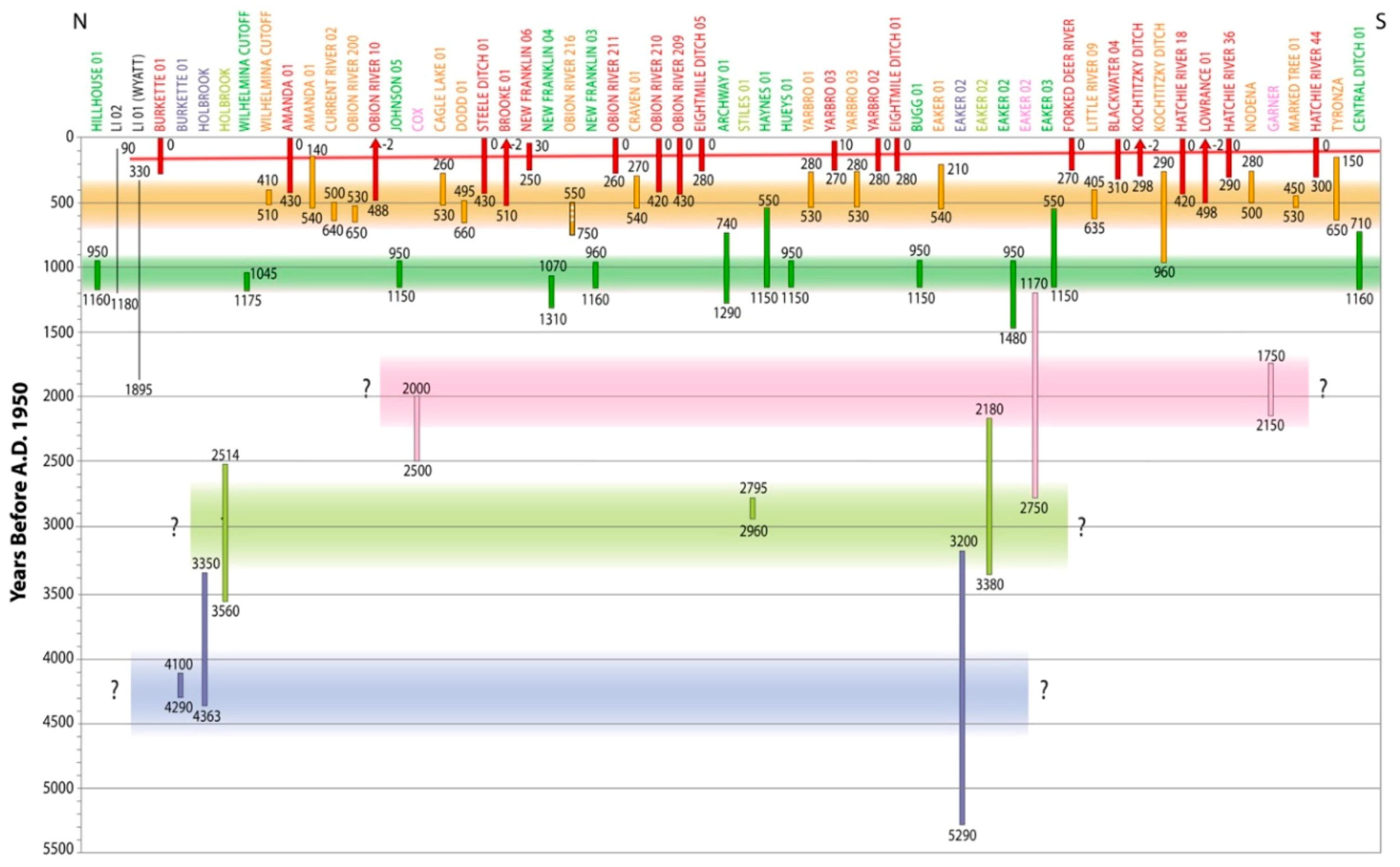
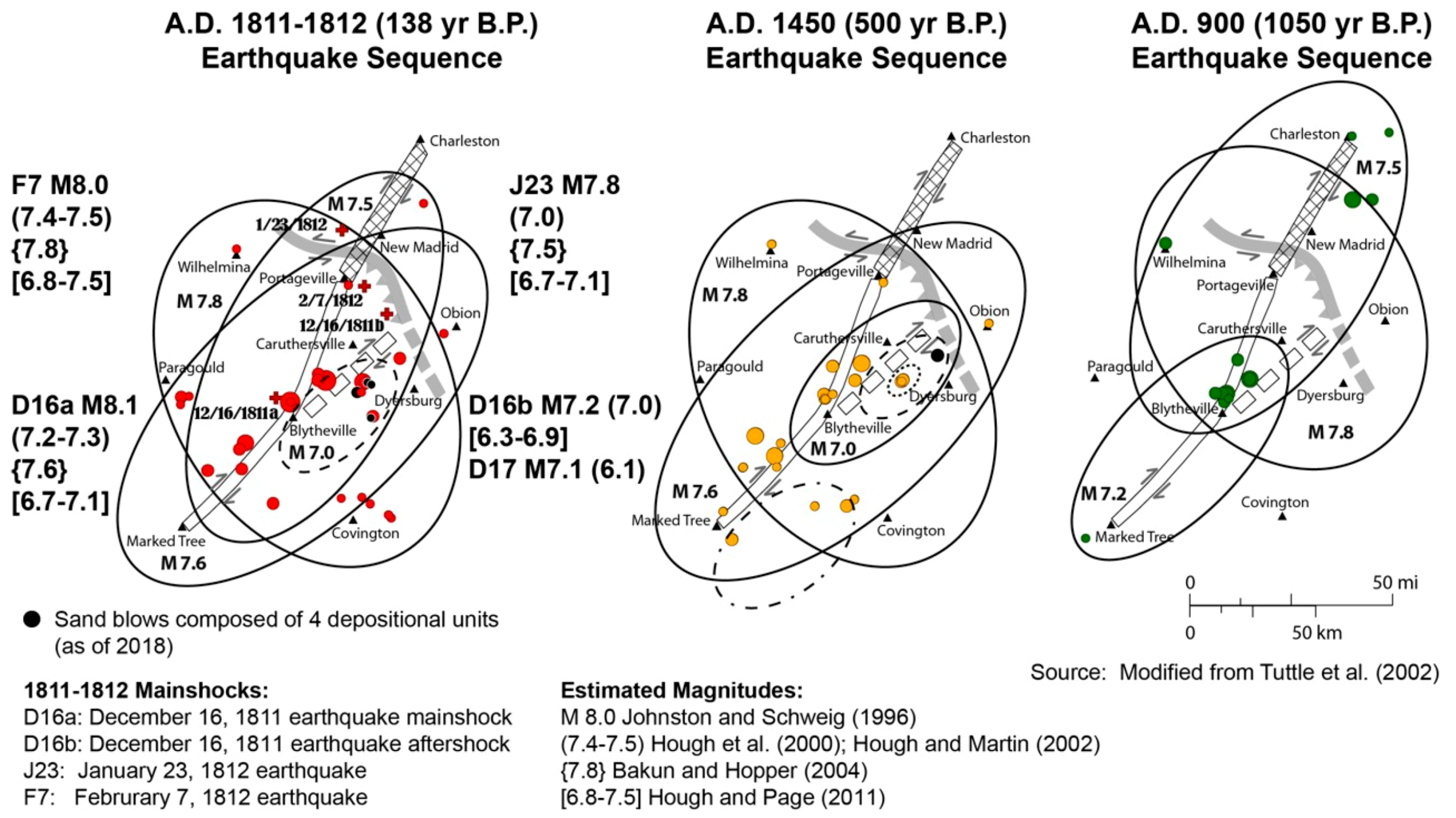
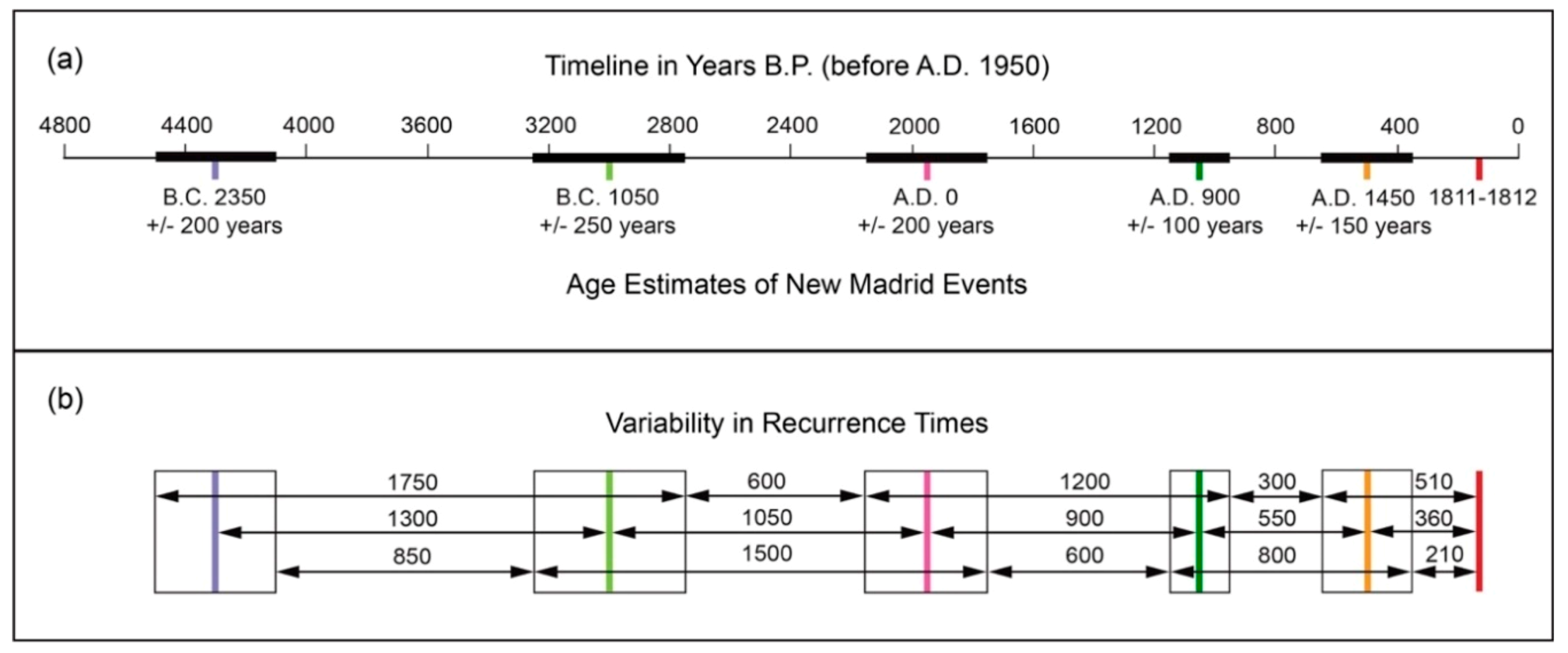
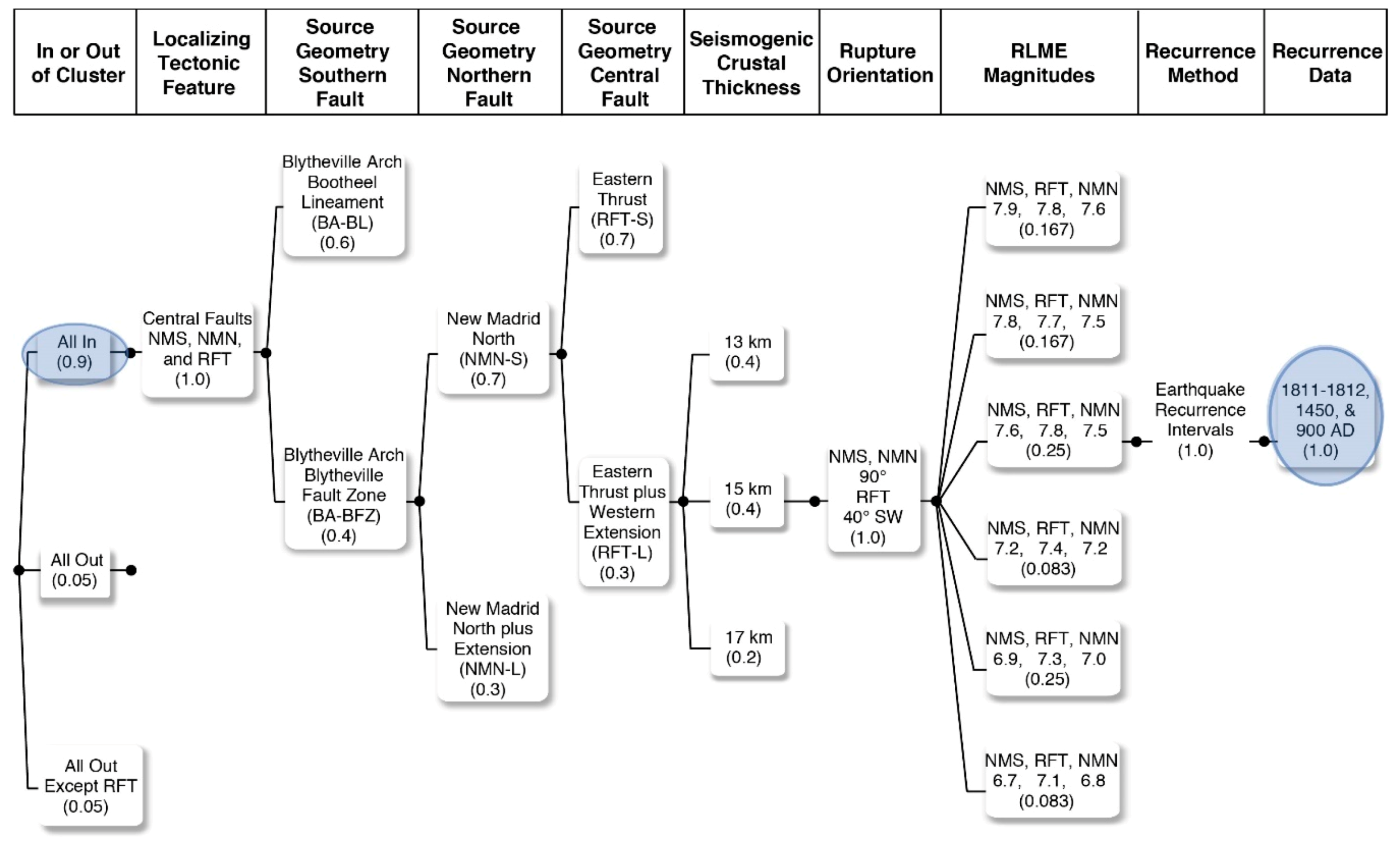
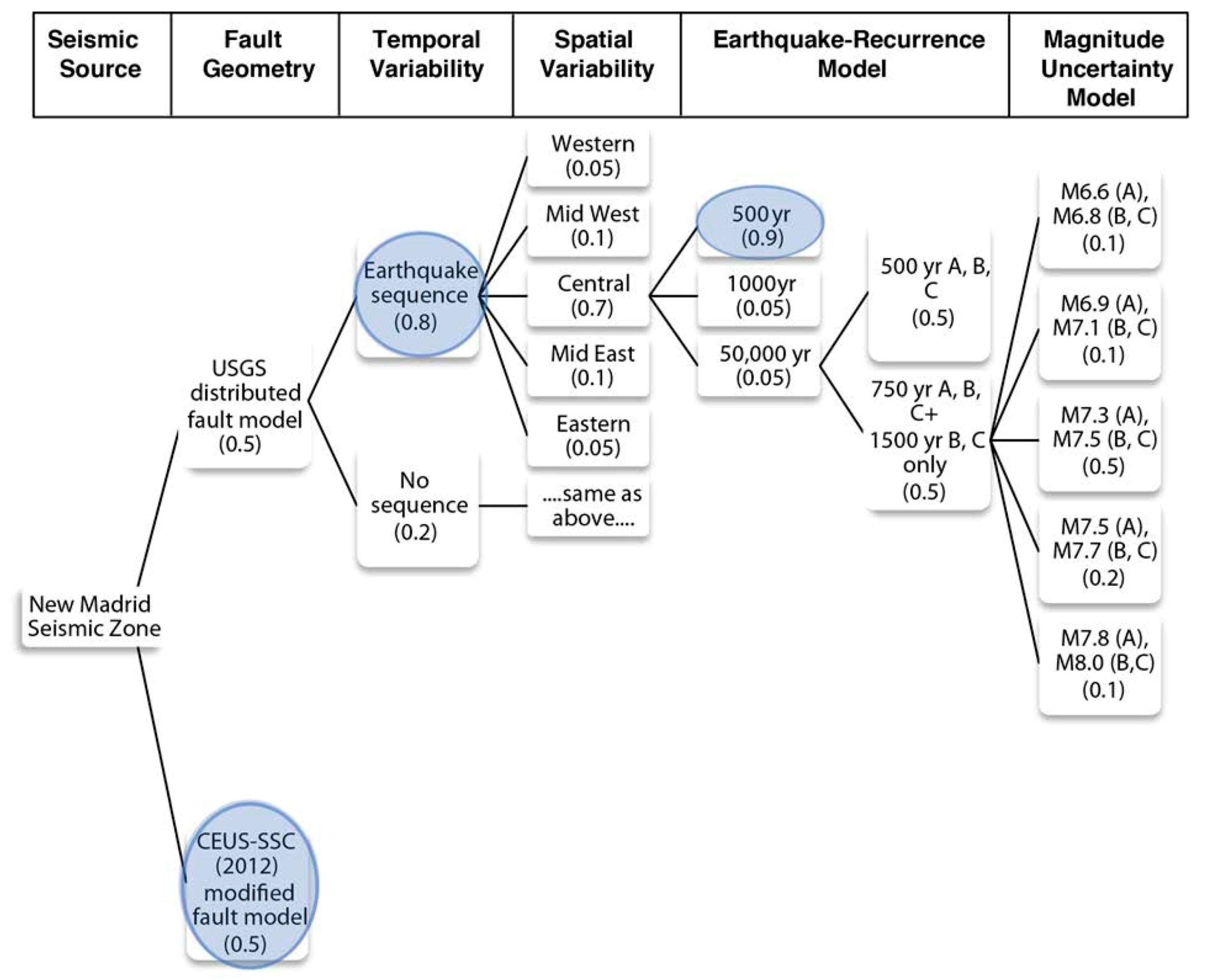
| Test Name | Observation | Limitation |
|---|---|---|
| Sudden formation | Structure formed more suddenly, and perhaps more violently, than any non-seismic alternative | May be unable to rule out some nonseismic origins without additional evidence |
| Synchronous formation | Nearby structures of same type formed at times indistinguishable from each other | May be unable to rule out some nonseismic origins; dating and correlation lack resolution to distinguish synchronous from near-synchronous formation |
| Zoned distribution | Size of structure decreases away from a central area | Cannot rule out earthquake origin |
| Size | Structure not larger than similar structures formed by historical earthquakes | Maximum size may be unknown; cannot rule out an earthquake origin for small structures |
| Tectonic setting structure | Seismic shaking strong enough to form the structure occurs more frequently than nonseismic alternatives in modern analog settings | Threshold magnitudes and accelerations for formation are only generally known |
| Depositional setting | Seismic shaking by itself forms the structure in similar modern deposits | Difficulty in recognizing some newly formed structures in the field |
| Earthquake Parameter | Range in Uncertainty | Factors that Contribute to Uncertainty | Observations and Analyses that Reduce Uncertainty |
|---|---|---|---|
| Timing | 10s–1000s of years |
|
|
| Location | Few–100s of km |
| (1) through (3) above
|
| Magnitude | 0.25–1+ unit | (1) through (4) above
| (1) through (8) above
|
| Recurrence time | 10s–1000s of years |
|
|
© 2019 by the authors. Licensee MDPI, Basel, Switzerland. This article is an open access article distributed under the terms and conditions of the Creative Commons Attribution (CC BY) license (http://creativecommons.org/licenses/by/4.0/).
Share and Cite
Tuttle, M.P.; Hartleb, R.; Wolf, L.; Mayne, P.W. Paleoliquefaction Studies and the Evaluation of Seismic Hazard. Geosciences 2019, 9, 311. https://doi.org/10.3390/geosciences9070311
Tuttle MP, Hartleb R, Wolf L, Mayne PW. Paleoliquefaction Studies and the Evaluation of Seismic Hazard. Geosciences. 2019; 9(7):311. https://doi.org/10.3390/geosciences9070311
Chicago/Turabian StyleTuttle, Martitia P., Ross Hartleb, Lorraine Wolf, and Paul W. Mayne. 2019. "Paleoliquefaction Studies and the Evaluation of Seismic Hazard" Geosciences 9, no. 7: 311. https://doi.org/10.3390/geosciences9070311
APA StyleTuttle, M. P., Hartleb, R., Wolf, L., & Mayne, P. W. (2019). Paleoliquefaction Studies and the Evaluation of Seismic Hazard. Geosciences, 9(7), 311. https://doi.org/10.3390/geosciences9070311




